

SILVER LINING
INSIDE: The fabulously ornate architecture that took its inspiration from tableware



INSIDE: The fabulously ornate architecture that took its inspiration from tableware
THESE pictures show off some of the eye-catching eco-projects in
Dubbed Internalities: Architectures for Territorial Equilibrium, the Spanish Pavilion is all about saving the planet - brick by brick. Curated by architects Roi Salgueiro and Manuel Bouzas, the show takes aim at construction’s dirty secrets - pollution, waste, and vanishing local skills - and flips the script.
Instead of hauling in materials from across the globe, the exhibition champions homegrown, low-impact solutions. Sixteen standout projects from all over Spain take centre stage, each built using smart, sustainable techniques - think wood from Cantabria, earth walls from Catalunya, and emissions-cutting hacks from the Balearics. Five themed zones - Materials, Energy, Labour, Waste, and Emissions - drive the message home.

GREEN REBUILD: Local materials were used to bring this ruined barn back from the dead in a sustainable way

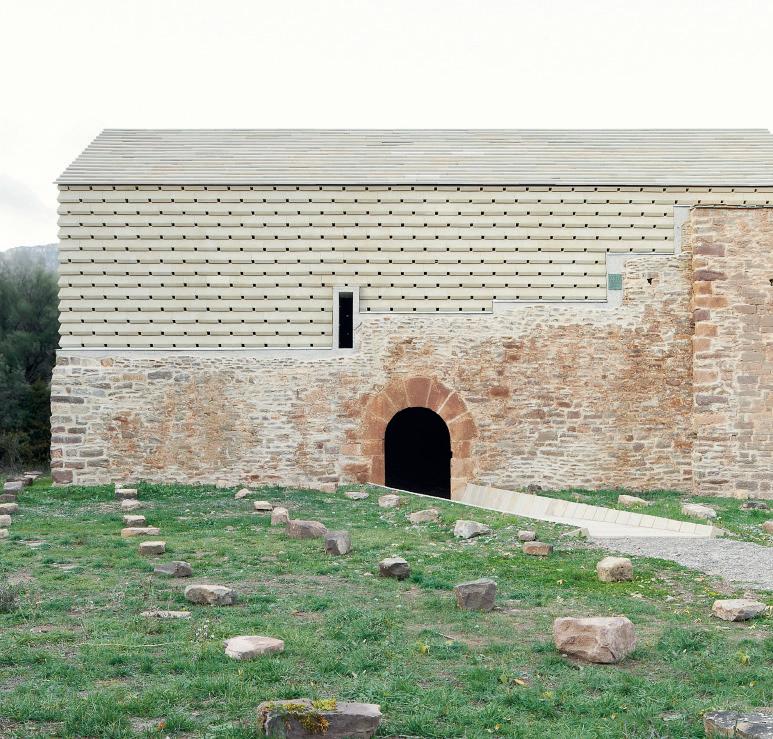


HOMEBUYERS in Spain are being completely ripped off when it comes to property taxes.
Purchasers pay a shocking third of a property’s purchase on extra costsby far the highest in Europe.
According to a report by the Institute of Economic Studies (IEE), they pay an effective tax rate of 30.3% when purchasing a home.
This is almost five times the European average of 6.5% and second only to Canada across the OECD western world nations.
Up to a quarter of the home’s final price is attributed to taxes alone, while further costs go in conveyancing and agent’s fees.
By Tom Ewart Smith
IEE President Iñigo Fernandez de Mesa called the situation ‘surprising’, noting that housing - a basic necessity - is ‘so severely penalised’.
The think tank warns the heavy tax load is widening the gap between supply and demand and making it increasingly difficult for Spaniards to
HomebuyersinSpainface‘highesttax burdeninEurope’withathirdof property purchasesnotonbricksandmortar
access affordable housing. But it is unlikely the government will want to change things with Spain’s housing-related taxes generating around €52.2 billion annually, or 3.5% of the country’s GDP.
Property Tax (IBI) makes up nearly 30% of the total, followed by VAT and income tax. The Property Transfer Tax (ITP) stands at 11%, among the highest in Europe, while capital gains tax on
sales can reach 30% - almost double the EU average.
Regional disparities are stark, however, with the Balearic Islands levy up to 13% ITP on new builds, compared to 6% in Madrid.
The IEE lauds Madrid’s approach as a model of fiscal competitiveness.
The think tank also warns Spain needs 2.2 million new homes by 2040, requiring €380 billion in investment - far beyond the public sector’s reach.
It is urging sweeping tax reforms, including cuts to transaction and property taxes, incentives for landlords, and a reduced VAT rate on renovations to ease the housing squeeze.

November 29thDecember 12th 2023

Mark Stucklin www.spanishpropertyinsight.com
THE number of home sales involving foreign buyers in Spain hit a record high in the first quarter of 2025, defying expectations of a post-boom soft landing. Instead of reverting to pre-2020 norms, foreign demand appears to have shifted structurally to a higher level.
According to data just published by the Land Registrars, there were 21,525 sales involving foreign buyers inscribed in the Land Registry between January and March this year— the highest Q1 figure on record. That’s more than in the same period of the boom years of 2022 and 2023,
when pent-up demand from Covid lockdowns fuelled a surge in purchases. By contrast, this year’s numbers reflect solid, organic demand with no clear boost from prior distortions. Foreign demand has not only rebounded—it has stepped up to a new level. Before the pandemic, the average foreign market share (FMS) stood at 12.6%, whereas since 2021 the average has been closer to 14%.
In Q1 2025, the FMS was 14.1%, close to the record high of 14.5%
seen in recent years. Rather than softening as I expected, the market has bounced back from a dip in Q1 2024, with both foreign and domestic demand registering annual increases. Foreign demand rose by 19% year-on-year, while local demand grew by 20%—though foreign sales are significantly higher relative to the decade average (+50% vs. +40%).
British still on top, Americans growing fast

STAGGERING: The foreign buyer growth spurt since 2021 continues this year
By nationality, the British remained the largest group of foreign buyers with 2,110 purchases, followed by the Germans (1,626), Dutch (1,549), and the French (1,314).
The French, once a fixture in the top three, have now slipped to fourth place, perhaps due to problems back home.
In year-on-year terms, US demand saw the strongest growth of any nationality, surging 57% to 520 purchases—well ahead of the Dutch, who rose by 36%.


GROWTH: Year-on-year growth shows Americans on top, while in actual numbers (top) the Brits are still ahead
All the major European markets grew in Q1, with the sole exception of Russia, which fell by 6%. Even the British market, which had declined in seven of the last nine quarters, managed to grow by 7%.
What’s driving the lasting boom?
Buyers from a wide range of countries appear to be responding to a mix of global uncertainty and Spain’s perennial attractions: safety, sunshine, high quality of life, and good value for money in real estate.
But the standout growth from the US could be linked to political jitters, with a spike in interest from Americans possibly tied to the election of Donald Trump. A strong dollar in 2024 may have helped fuel purchases too, although the currency has since weakened, raising questions about whether US demand will sustain its momentum.
As things stand, however, the outlook for foreign demand remains strong across the board. When the world gets messy, Spain’s property market seems to shine.


A BRITISH entrepreneur has been revealed as the owner behind Spain’s most expensive home.
Joe Ricotta is selling a spectacular Marbella mansion, Villa Bellagio, priced at an eye-watering €70 million.
The British businessman is best known for founding one of the UK’s leading refrigerated logistics companies.
A friend to celebrities including Rob-
ert de Niro, Michael McIntyre and Tyson Fury, he sold the business for a reported €52.5 million in 2015. Since exiting the logistics world, he has turned his attention to luxury property development in Spain, Italy and the UK - with this Marbella jewel his most extraordinary venture yet. Villa Bellagio spans an extraordinary 5,600 square metres in size built on a vast 14,000 square metre plot - the largest in the Sierra Blanca.
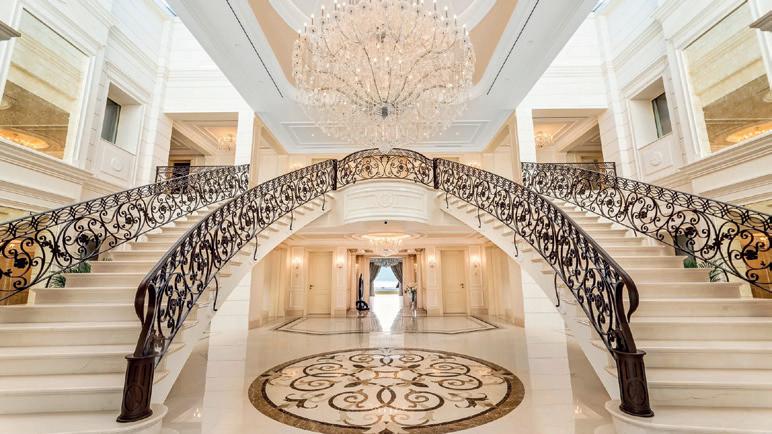
SPAIN’S housing crisis is worsening, with new data showing renters now spend nearly 47% of their gross income on housing - the highest in five years.
A study by InfoJobs and Fotocasa reveals rent hikes are far outpacing wage growth, straining affordability nationwide.
While average salaries rose 3.1% in 2024 to €27,060 annually, rents surged 14%. The average price is now €13.29 per square metre, meaning tenants in an 80m² flat pay about €1,060 monthly.
Fotocasa’s Research Director Maria Matos warned that spending close to 50% of income on rent far exceeds the 30% affordability benchmark, increasing housing insecurity.
In Madrid, renters spend 71% of income on rent. With average wages at €2,340 and rent at €20.62/m², a typical flat costs
€1,650, while in Barcelona, renters use 64% of income.
Fifteen of 17 regions saw double-digit increases in income share spent on rent. The Basque Country (56%), Canary Islands (55%), and Valencia (47%) are among the hardest hit.
InfoJobs’ Monica Perez noted: “It’s not just young people. Inflation and rent hikes are eroding household budgets.”


of the Mediterranean, plus a 22-metre infinity pool melt-

ing into the horizon. It counts on 13 luxurious bedrooms, including eight 50 m2 suites on the upper floors, all dripping in opulence and space.
However, it is the lower level that truly sets Villa Bellagio apart.

sauna, massage rooms, and even a professional hair and beauty salon.
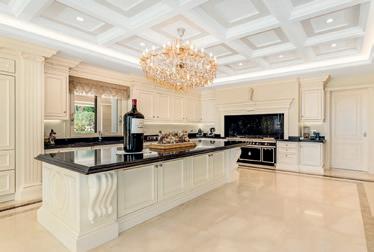

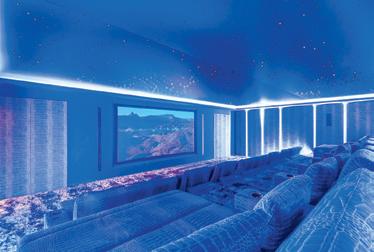
offers a
Designed by renowned architect Jesus del Valle it has incredible panoramic views
Described as resembling a private wellness resort, it features a fully equipped spa, heated indoor swimming pool, Turkish hammam, Finnish
Fitness enthusiasts will find a stateof-the-art gym, while entertainment seekers can enjoy a double bowling alley, billiards lounge, stylish bar, and a private cinema that seats 22. For automotive fanatics, Villa Bellagio
FOREIGNERS make up 23% of Malaga province - with Brits high in the rankings. Some 414,316 out of 1.7 million
residents are born abroad, according to official Spanish statistics. It makes Malaga the province with the fifth highest number of for-
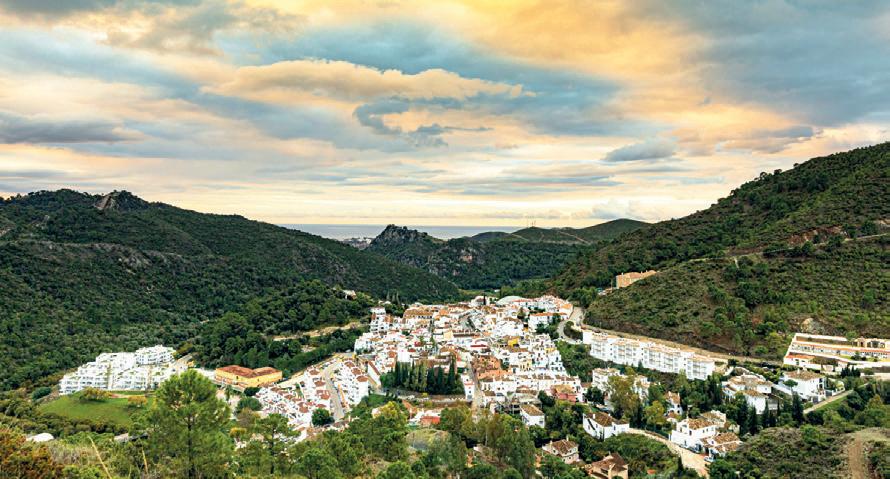
IT has long been known as the wealthiest town in Andalucia.
Now it has been confirmed that Benahavis is also the municipality with the highest proportion of foreign residents in Malaga province.
New stats from Spain's National Statistics Institute reveal that more than 60% of Benahavis’ 9,256 residents were born outside Spain, mostly from other EU countries.
They account for 5,919 of its 9,265 inhabitants with Brits the largest number.
They make up 1,388 of the population, followed by Russians (556).
And most of them are comfortably well off when it comes to income - the average resident earns more than €40,000 a year.
A DERELICT school has been transformed into eco-friendly housing for residents over 65, setting a new benchmark in sustainable design.
H Arquitectes led the project, reusing local mares stone from the demolished building to create structural blocks - cutting waste and carbon emissions. The 25 compact flats feature cross-ventilation, thermal massing, and private outdoor space. Communal areas include a rooftop garden, laundry, and lounges.

Census reveals over 20%of people livinginMalagaare foreignwithBrits leadingtheway
By Yzabelle Bostyn
eign residents, following Madrid, Barcelona, Alicante and Valencia. However, the proportion of inhabitants born outside of the country is larger in other areas such as Almeria and Tenerife (24%), as well as Girona, the Balearic Islands and Alicante (26 to 27%).
A third of the province’s towns (35) have more than 20% foreign residents.
And Benahavis tops the list with the highest percentage of residents (64%) being foreign It is followed by Fuengirola, with 44.6% foreign residents, mostly made up of Finns and Brits.
Competa meanwhile sees 44% of its residents born abroad while in the village of Sayalonga, 700 of its 1,624 residents are foreigners.
In Manilva and Torrox, the proportion of foreign residents is 40%, with most coming from Britain, Germany and Morocco. Meanwhile in Marbella, around 60,800 of the city’s 159,054 population were born abroad, accounting for 37%.
The biggest community hails from Morocco, followed by Colombia, Argentina, Britain,
Stones from the early 20th-century school were broken down and cast in concrete, forming a strong new material. MAC Insular, a private recycling firm, processed over 1,000 tonnes of demolition waste, reusing 95%.
Despite some use of cement, the project is seen as a success in ‘urban mining’, showing that quality, lowcost housing can be both functional and sustainable.
Ukraine and Russia.
In Mijas, over a third of the town’s 92,211 local residents are foreign (34,700), with mostly Brits (7,193), Moroccans (3,617) and Argentinians (3,208).
Some 34% of Nerja was born outside of Spain, with Brits leading the way followed by Argentinians. Similarly, Brits are the biggest foreign population in Alhaurin el Grande (2,279) and Coin (1,700).
On the lower end of the scale, just 15% of the population of Velez-Malaga and Malaga capital are from overseas, with most hailing from Latin America.
A NEW app is giving renters the power to share honest reviews and uncover the hidden truths about potential homes.
Launched last year by the Barcelona Institute for Urban Research, Reviu lets tenants post experiences and read reviews of properties, neighbourhoods, and landlords.
Co-founder Jaime Palomera says the app could soon act like Booking.com - offering listings, reviews, and bookings.
“We want to bring transparency to an opaque rental market and reward fair practices,” he said. The platform, already live in Barcelona, will expand across Catalunya in the coming weeks, with national rollout to follow.
Users can now search by neighbourhood or agency - an upgrade from the previous address-only system.
Reactions have been largely positive, despite some estate agent concerns.
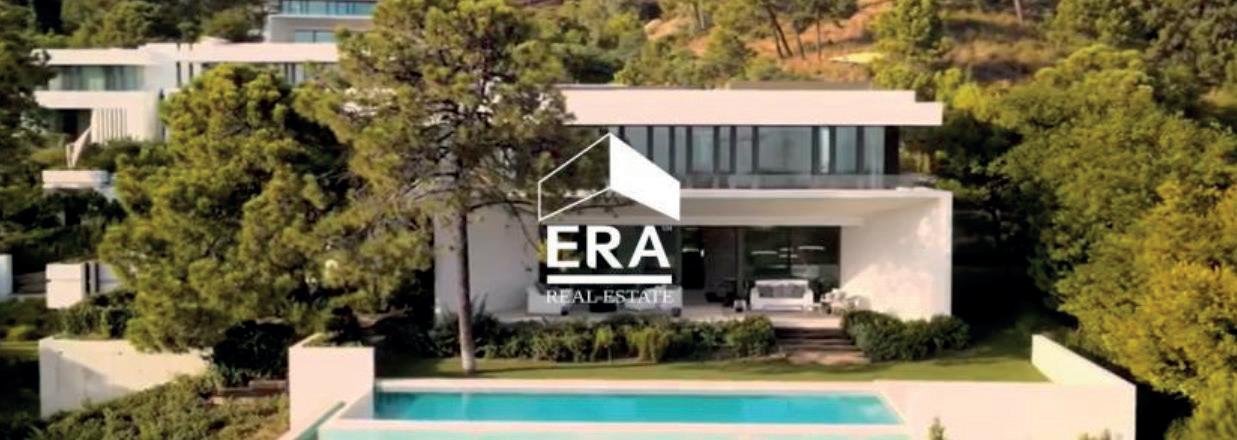











Trusted experts offering bespoke property services across southern Spain
ANDALUCIAN
Property Sales

is a legally registered Spanish business run by Diane Heston and her team of bilingual professionals.
With over 20 years of experience in the stunning province of Jaen, the team specialises in property sales throughout Andalucia, offering clients a personalised and pressure-free experience when buying a Spanish property.
They provide expert help, support, and guidance throughout your property search, purchase process, and with dedicated after-sales service.
Andalucian Property Sales features a diverse portfolio of properties, ranging from charming village houses to expansive country fincas and cortijos. While based in Jaen, they also list properties in the provinces of Granada, Cordoba, Malaga, and Almeria. They cover popular towns and villages such as Alcala la Real, Alcaudete, Castillo de Locubin, Martos, Iznajar, Nerja, and Arboleas, among others.
For all your inland Andalucian property needs, contact Diane and her team today.
Visit www.andalucianpropertysales.com or call +34 669 249 539 to begin your journey to discovering the real Andalucia.

Barcelona unveils ambitious plans for three landmark halls to mark the centenary of the 1929 International Exposition
Offering you help, support and advice during your search, through the buying process and personal after sales services.
Search www.andalucianpropertysales.com or call +34 669 249 539 to start your discovery of the real Andalucia
We have a wide range of properties to interest our clients, from small village houses to large country fincas or cortijos.


Tel/WhatsApp: (+34) 669 249 539 email: info@andalucianpropertysales.com www.andalucianpropertysales.com

Find your property for sale on the Costa del




By Dylan Wagemans

BARCELONA’S Montjuïc is gearing up for a major transformation, and plans for three significant new structures have been unveiled.
This initiative is part of the centenary commemoration of the 1929 International Exposition that took place on the hill.
These proposals offer an initial look at a comprehensive renovation project aimed at revitalizing the well-known Montjuïc hill area.
The plans address the renovation from three distinct perspectives.
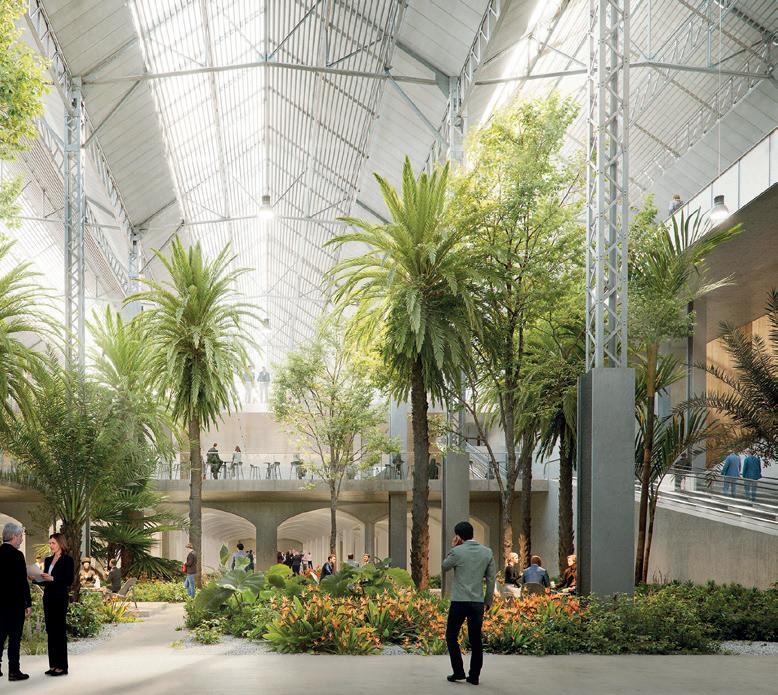

Firstly, there’s the construction of a ‘Multifunctional Palace’ along with the refurbishment of the existing ‘ Communications Palace’.
Secondly, the proposal includes the development of a new Barcelona Conference Centre within the current Alfonso

Offering you help, support and advice during your search, through the buying process and personal after sales services.
We have a wide range of properties to interest our clients, from small village houses to large country fincas or cortijos.
XIII Palace. And thirdly, there are plans to remodel the ‘dress palace’ with the future intention of establishing it as an innovation hub for trade fair activities.
The Barcelona Council’s Commission for the Centenary has released images of the winning architectural designs. A key

RENDER: A massive new ‘multifunctional palace’ is planned for the site consideration in these plans is sustainability, aiming to transform Montjuïc by blending modern design with the historical surroundings.
The construction of these three halls will mark the first phase of this significant renovation of a city landmark. The city council has stated that the ultimate goal is to create a cutting-edge urban space for exhibitions and events suitable for the 21st century.
The selection of the winning designs was made
Continues on next page


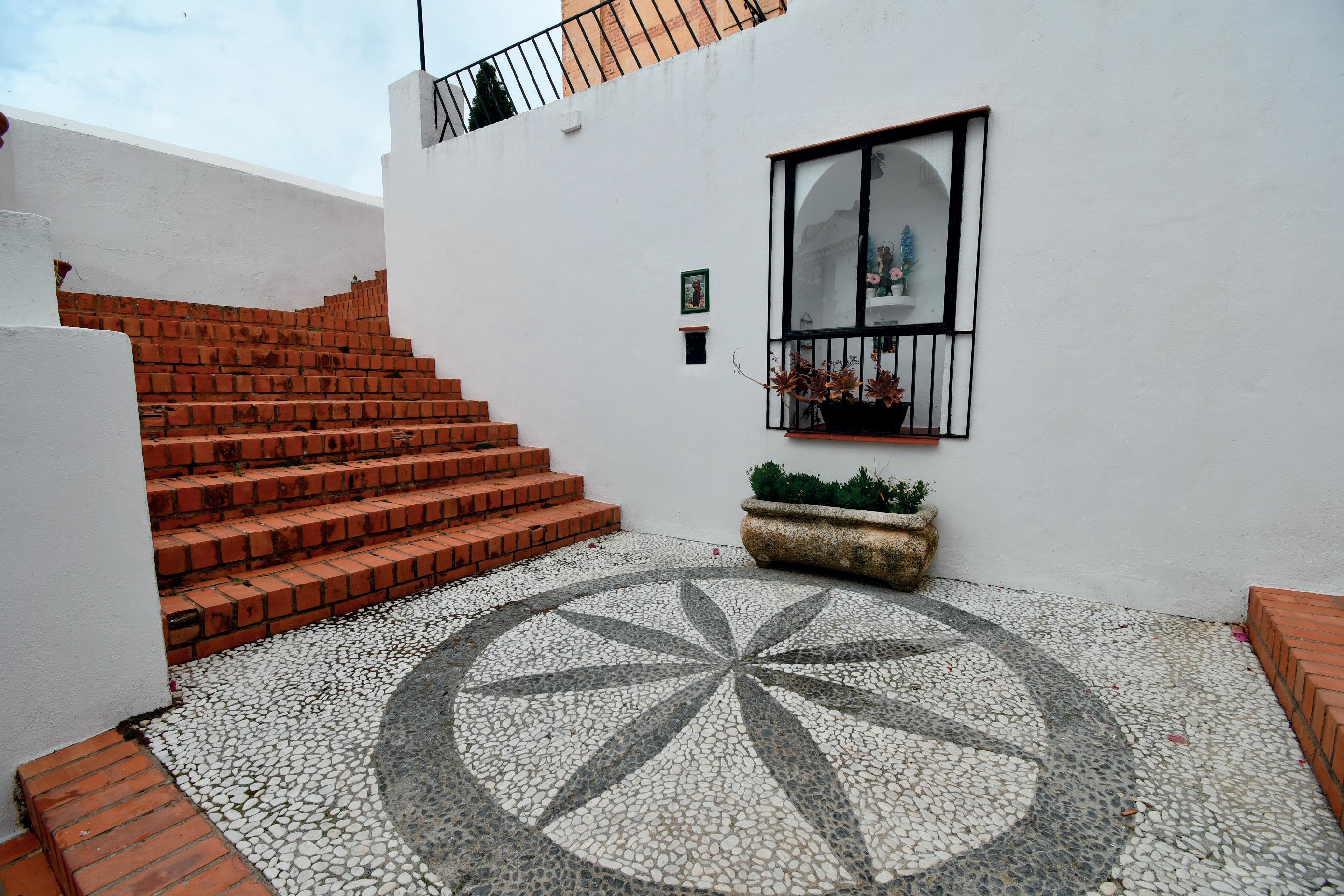

From previous page
by a panel of five experts, chaired by the architect Josep Lluis Mateo. Important criteria for selection included the optimisation of the exhibition facilities to make them more adaptable and versatile, with a strong focus on efficiency and sustainability. In terms of energy, the new buildings are designed to be entirely self-sufficient through reduced consumption via high-efficiency installations and the use of energy-producing aerothermal and geothermal systems.
Construction for this initial phase is scheduled to begin in early 2026, with an expected completion date in 2029.
This timeline coincides with the centenary celebrations of the 1929 International Expo. The total estimated cost for this first phase of the project is €255 million. Furthermore, a new architectural competition will

be launched for the second phase, which involves the remodelling of the Palacio de las Comunicaciones. Trade fair activities will continue throughout the renovation process.
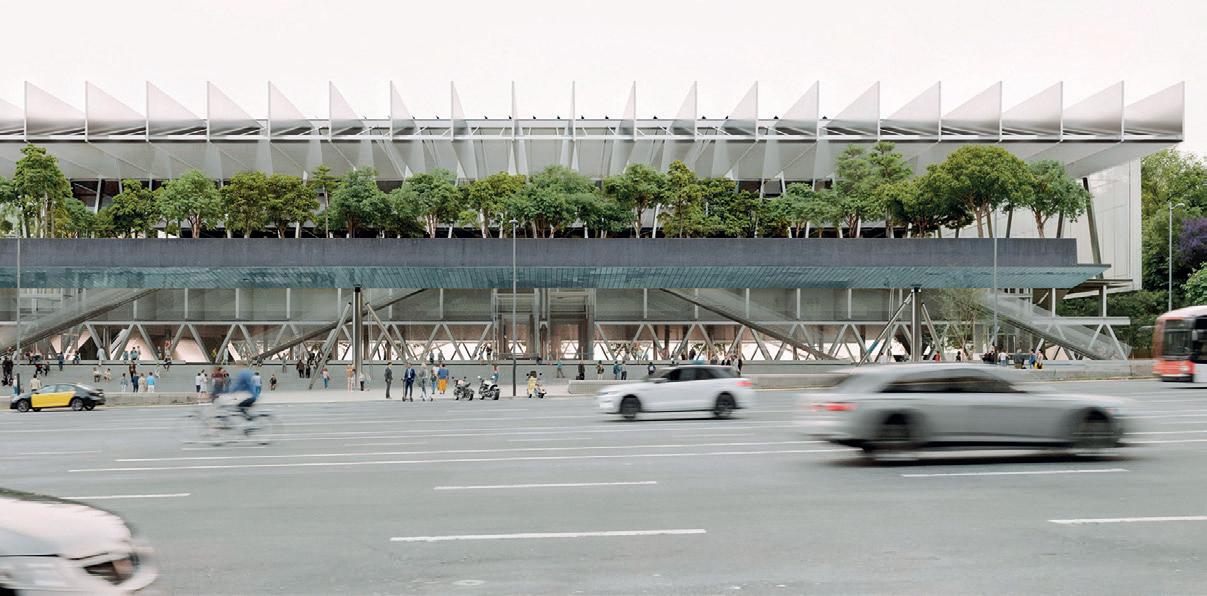
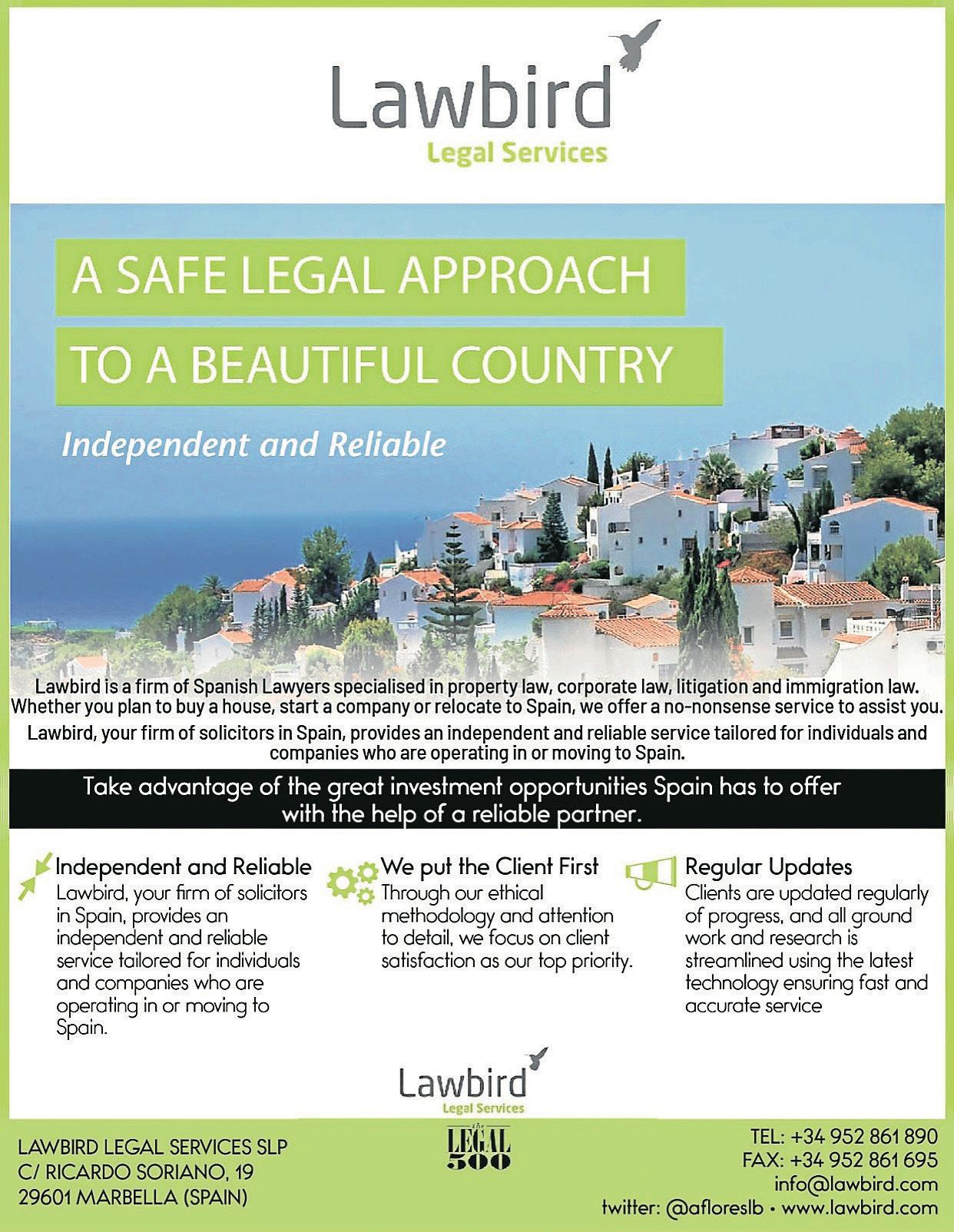
PLANNED: A conference centre is slated to be built within the current Alfonso XIII Palace.
Regarding the specific projects, the first contract was awarded to the team behind the Multifunctional Palace and the renovation of the Communications Palace, designed by architects Smiljan Radic, Miquel Marine nuñez, Beatriz Borque, and Cesar Rueada Bonet.
The second winning proposal, which includes the Barcelona Conference Centre, was developed by Forgas Architectes, Archambac, and Alvaro Alejandro Fernandez. Their design features a garden courtyard, an exhibition hall, and an auditorium with a capacity of 2,025 people. The third winning design proposed a three-story Z-shaped building, a plan created by Bjarke Ingels Group and MIAS Arquitectura. This building will be surrounded by green spaces, with its entrance incorporating the existing columns of the Plaza España.




Great fully refurbished family villa in the Golf Valley
5 Beds | 4 Baths | 830m2 Built | 306m2 plot | 72m2 terrace
REF: 176-02953P | 2.795.000€
As you enter the living, dining and open plan kitchen you are greeted with an abundance of light and space. From here you have direct access to the beautifully manicured gardens, gazebo, heated pool and open terraces with shaded large sails for extra comfort. The house is well thought out creating private space on the master level and then you have 2 wings ideal for guest. There are 5 bedrooms and 4 bathroms, 3 of which are onsuite. On the living room level you have a laundry area and a guest toilet near by. The house was completely refurbished 6 years ago using natural colors to create a homely feeling. The house is complete with underfloor heating throughout, airzone ac systems both powered by an aerothermic system. This house is also ideal as a rental property due to its 5 bedrooms and distribution.



Newly fully refurbished duplex penthouse.
4 Beds | 3 Baths | 227m2 Built | 60m2 terrace
REF: 176-02831P | 1.295.000€
As you enter you are greeted by the light and the soft colour scheme creating a feeling warmth and luxury. The open plan kitchen, living and dining room opens up to double doors onto the lower terrace which is perfect for that morning coffee. On this floor you also have the 4th bedroom and the combined bathroom and guest toilet. On the 2nd floor you have the large mastersuite with plenty of wardrobe space, large bathroom and a beautiful bay window looking towards Marbella and the sea.
Large townhouse with sea & golf views.
3 Beds | 3 Baths | 100m2 Built | 165m2 terrace | 653m2 build
REF: 176-02826P | 895.000€
We present this special & classic property in the well known development of Los Jarales. Nestled in the heart of Aloha with views towards the Aloha golf course and across the valley. The spacious entrance takes you to the property through the large patio where you can enjoy the morning sun and its a perfect place for the warm summer evenings.


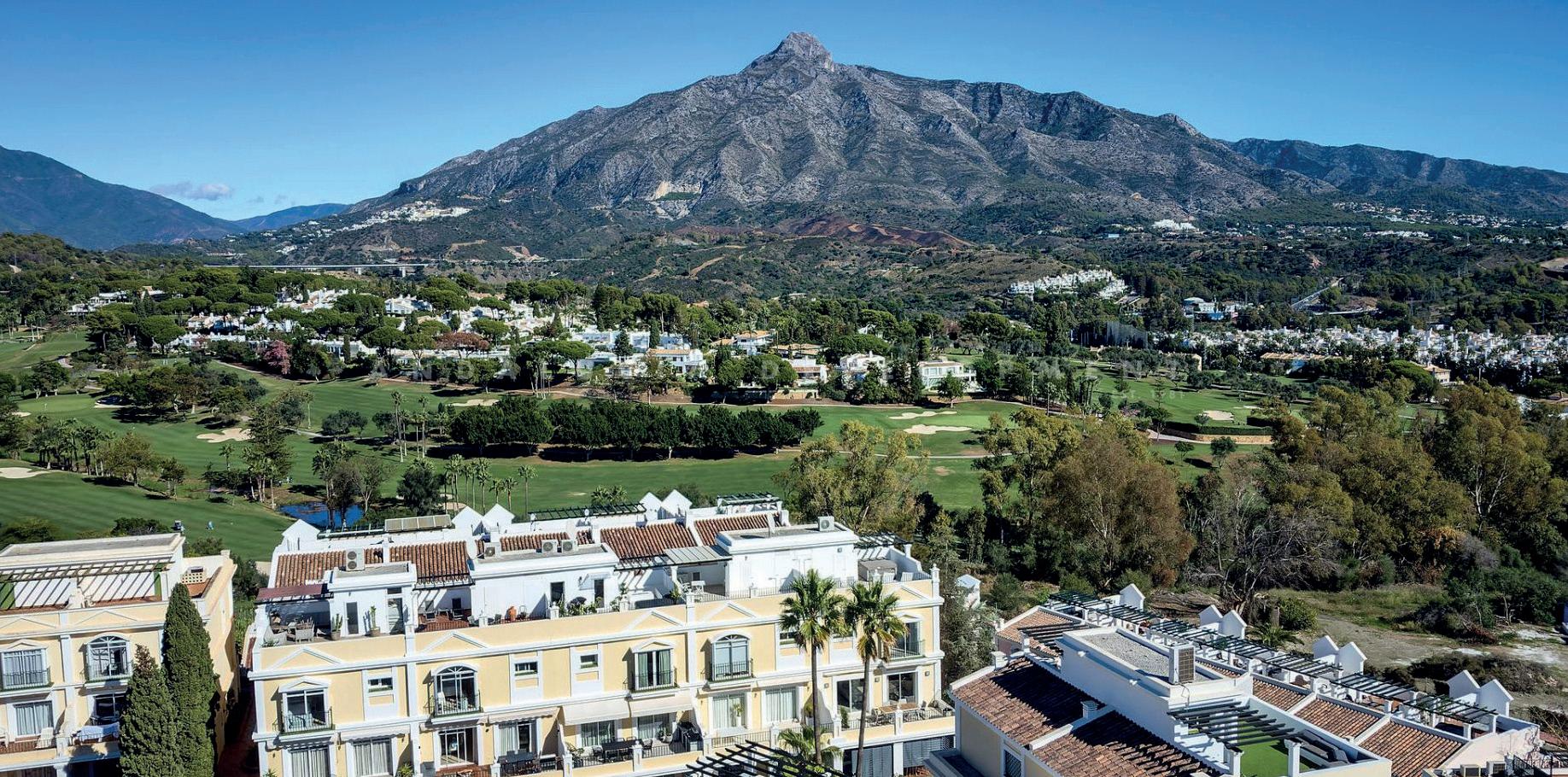



Salamanca’s Iglesia de San Esteban presents a towering facade, a grand and religiously significant example of Plateresque architecture. Carved from sandstone, its intricate details cover the surface, creating a visually impressive display. Ornamentation blends religious iconography with characteristic floral and figurative motifs. This monumental church facade stands as a testament to the artistic and spiritual fervor of the Spanish Renaissance.
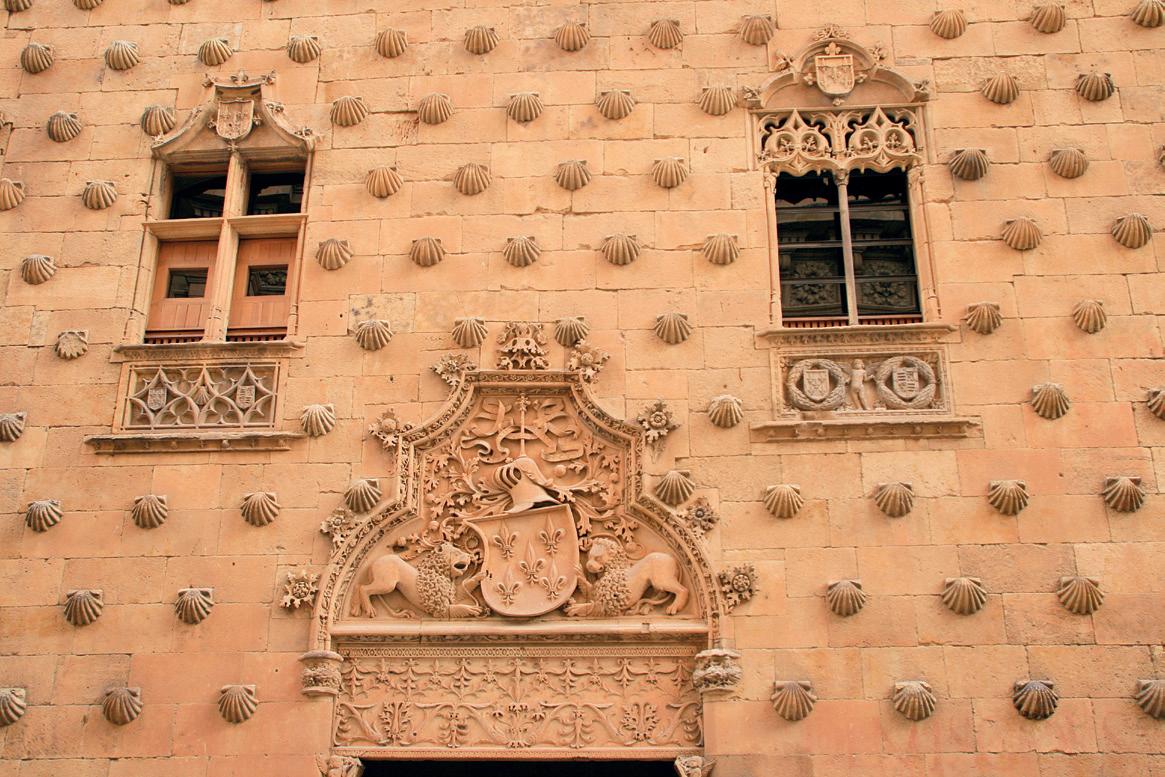

November 29thDecember 12th 2023
SILVERWORK is delicate and it’s all about detail, so when an exclusively Spanish style of architecture flourished in the time of Cervantes and Philip II, it earned the nickname ‘silver smithery’.
It’s now known today as the ‘Plateresque’ style.
Plateresque was an artistic movement, especially architectural, developed in Spain, between the late Gothic and early Renaissance periods in the late 15th century.
It carried on spreading for the next two hundred years, bringing joyful details to hundreds of grand buildings around the Iberian peninsula.
In architectural terms, Plateresque takes on from the Gothic style and is a heady blend of Mudejar and Flamboyant architecture with a touch of the Tuscan Renaissance movement.
Adorning some of Spain’s most celebrated buildings, it reached its apex during the reign of Charles V, with its epicentre in Salamanca.
However, it also flourished in many other Spanish cities and towns including Casares, Burgos, and Santiago de Compostela.

You can spot a Plateresque building from the ornate floral designs on its facades, as well as internal items such as its chandeliers, roofs and altars.
Above all, it was an artistic movement that responded to the demands of the It was a time of great optimism and wealth, coming as the Reconquest
The ornate Plateresque style flourished during Spain’s Golden Age, leaving a legacy of intricate
By Michael Coy

against the Moors was completed - in Granada in 1492 - and the colonisation of the Caribbean and the Americas was beginning, led by Christopher Columbus.
The Spanish were rapidly acquiring wealth and power - as the gold and silver began to flow from the New World - and this was reflected in the money spent on a series of new grand buildings.
The decoration, at its best on the facades, featured motifs of plants, as well as shields, medallions and even animals and insects.
You could often tell the owner of the building from the types of decoration, be they military shields for soldiers or laurels for lawyers.
And when we think of the word ‘ideals’, we need to pause and think.
The owners and builders of these structures wanted to ‘send a message’.
In an age when passers-by in the street were illiterate and clueless about aesthetics, the way to impose a sense of power and authority over them could be conveyed in the building’s look.
Salamanca’s Casa de las Conchas presents a unique facade, instantly recognisable for its distinctive shell-covered exterior. This curious and eye-catching design creates a textured surface, studded with hundreds of sandstone shells. Delicate ironwork details around the windows further enhance its ornamental character. Blending Gothic and Renaissance influences within the Plateresque style, this urban palace offers a fascinating and memorable example of Spanish architectural individuality.

Forget the concept of form following function, the wealthy aristocrats and conquistadores of Spain’s golden age were stamping down their power. It didn’t matter the extraordinary cost of creating wonderful ornate stone forms on their buildings. They had the money and they wanted to spend it. Here, the Olive Press picks its favourite Top 10 Platareque masterpieces
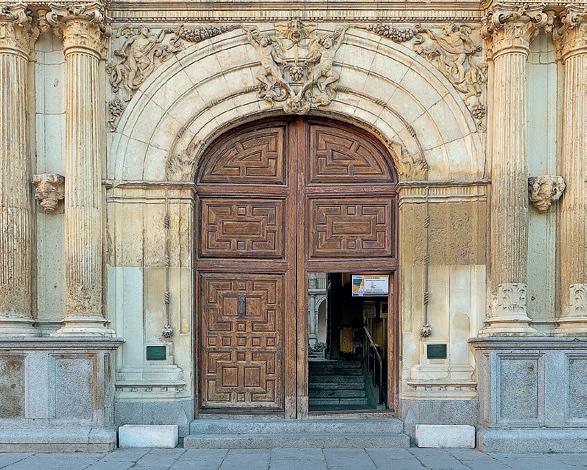

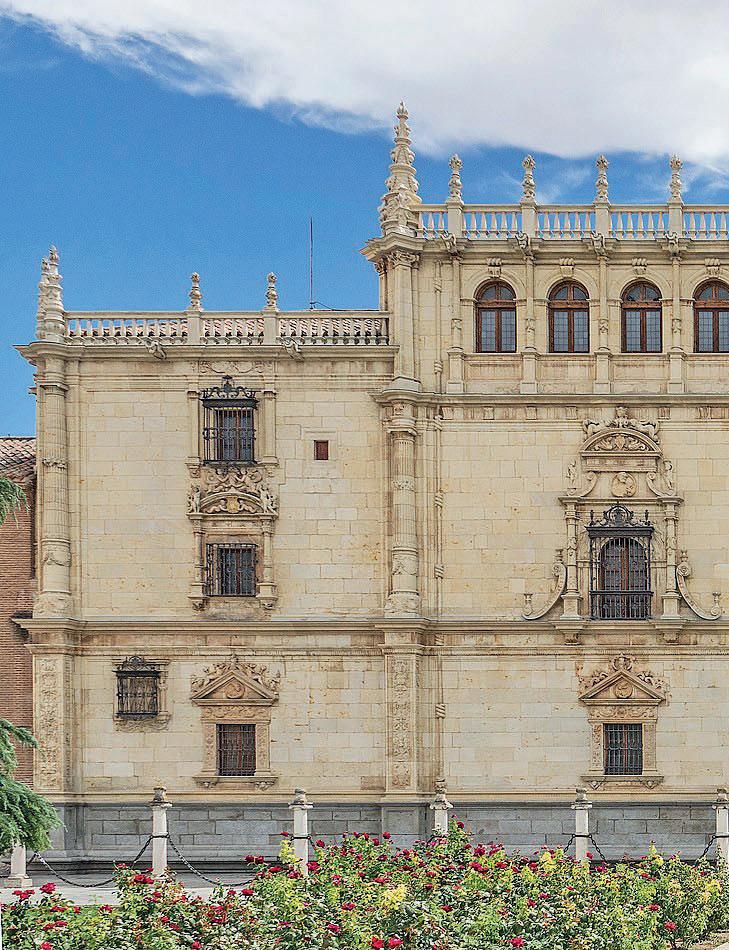
Salamanca’s Palacio de Monterrey is a prime example of the Plateresque style. Its facade boasts intricate, shallow relief carvings resembling silverwork. Delicate ornamentation frames windows and doorways, featuring floral motifs, mythological figures, and heraldic symbols, creating a rich and ornate surface.


Salamanca’s university features a majestic sandstone facade, a testament to the Plateresque style. Intricate carvings depict a wealth of detail, blending Gothic and Renaissance motifs harmoniously. Figurative sculptures and heraldic symbols adorn the surface, conveying academic prestige and historical significance. Delicate ornamentation, like sculpted silver, makes this facade a captivating example of Spanish architectural artistry.
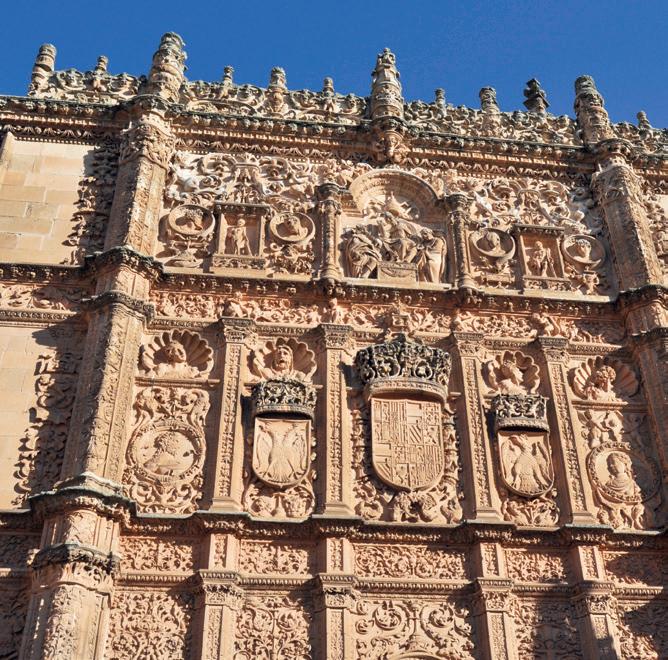
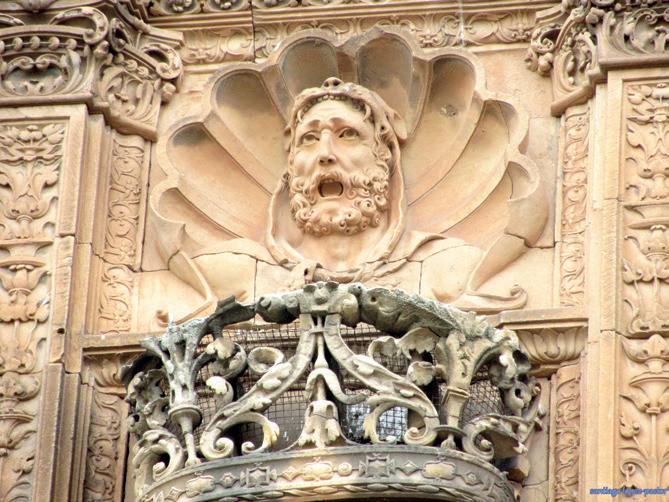




The Convent of San Marcos boasts a grandiose facade, an expansive and elaborate display of Plateresque artistry. Its symmetrical design features intricate sculpted details flowing across the sandstone surface. This
monumental structure exudes a regal and dignified presence, reflecting the power and wealth of the era. Refined ornamentation and impressive scale make it a significant cultural and artistic landmark in Spain.
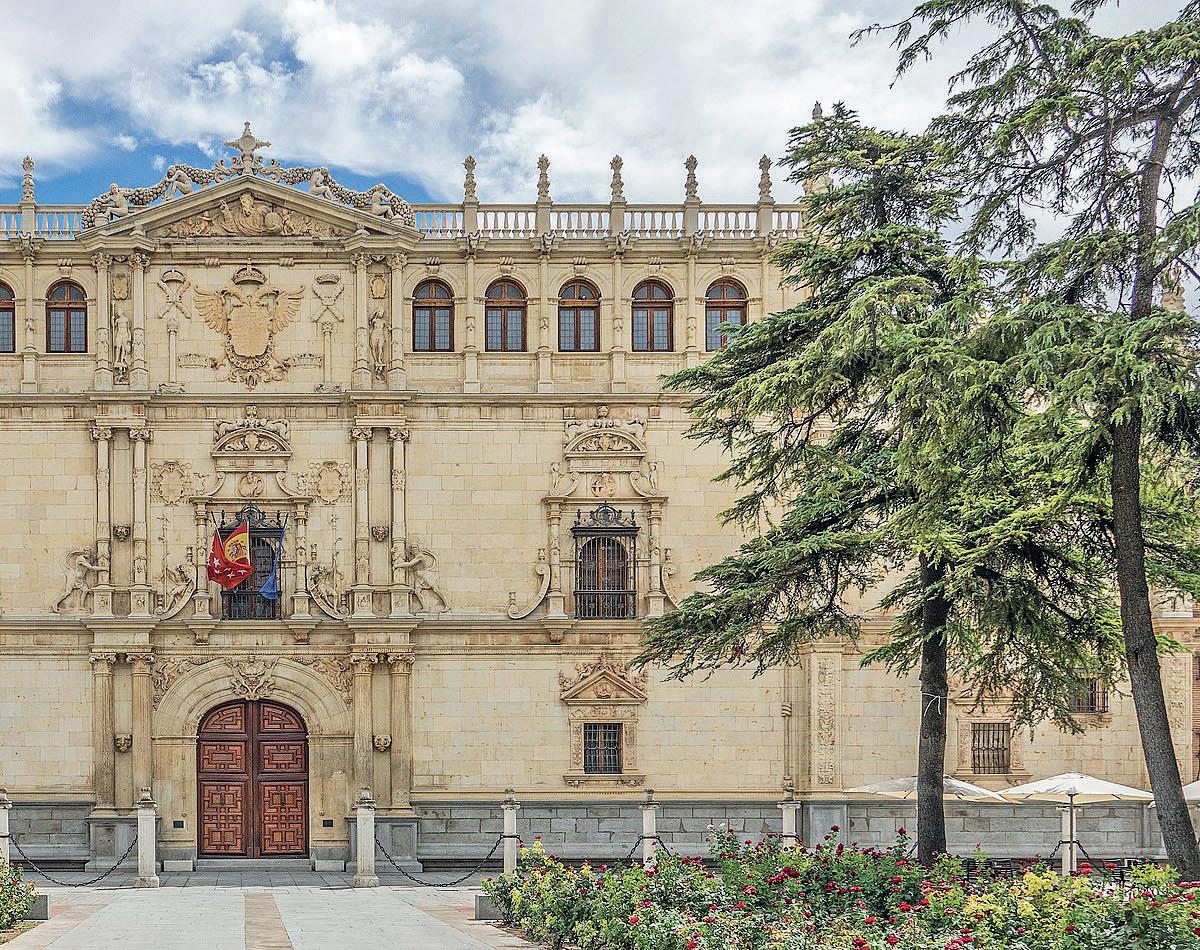
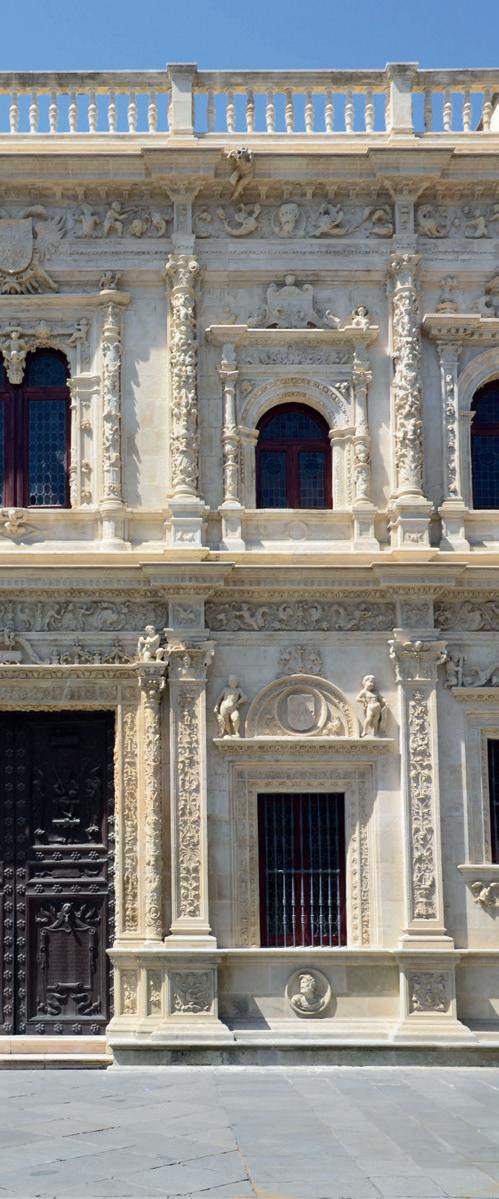
Colegio Mayor de San Ildefonso showcases the grandeur of Plateresque design with its imposing facade. A layered structure, incorporating brickwork and arched elements, exudes classical elegance and historical importance. Intricate detailing frames windows and doorways, while heraldic symbols and sculpted ornamentation add to its dignified appearance. This monumental facade reflects the prestige of this significant university and refined artistic sensibilities.
Santiago’s Hospital Real - today the parador hotel - features an imposing and symmetrical facade, exemplifying the grand scale often associated with Plateresque architecture. Detailed ornamentation and sculpted elements reflect Renaissance ideals embraced by the style. This historical building, once a royal hospital, now a parador, stands as a majestic and dignified landmark, showcasing intricate craftsmanship and artistic sophistication.


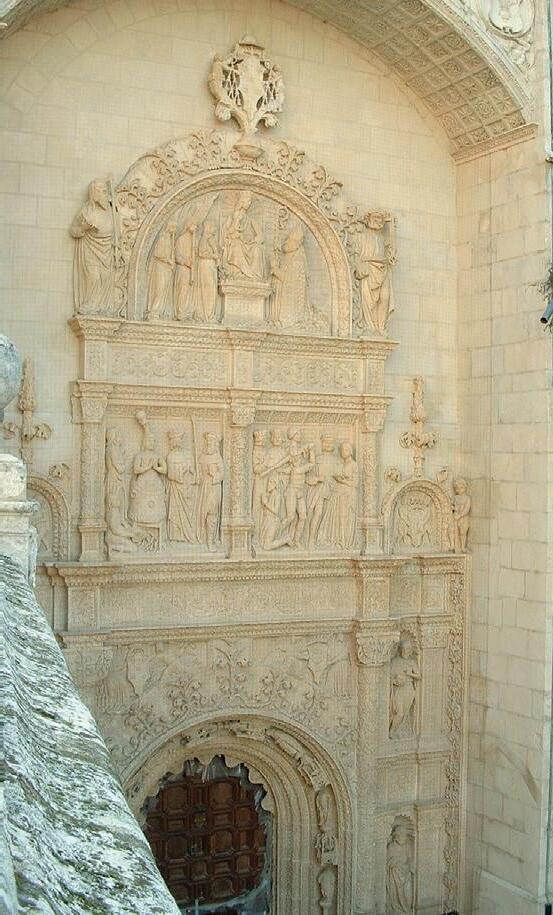
Burgos Cathedral’s Puerta de la Pellejería represents a transitional style, blending Gothic elements with the emerging Renaissance Plateresque. Detailed sculptures and an arched structure showcase the evolving artistic tastes of the period. Intricate ornamental work frames the doorway, adding delicate refinement to the cathedral’s imposing presence. This historical gateway serves as a testament to Burgos’ rich architectural heritage and the influence of Plateresque design.
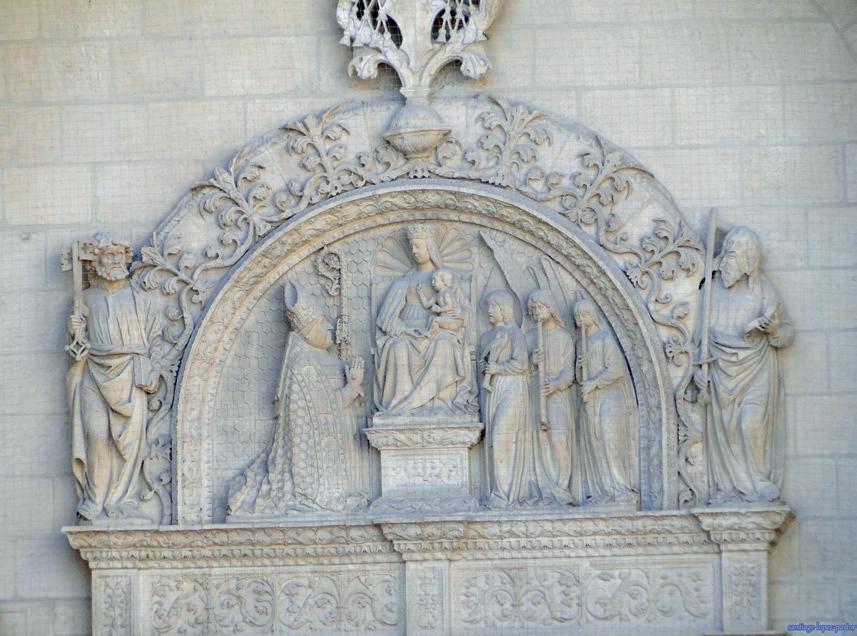
Sevilla’s town hall boasts a grand facade, a civic example of the Plateresque style, conveying historical authority and governmental importance. Its ornate detailing and sculpted elements are characteristic of the period, reflecting the city’s wealth and power. Intricate ornamentation frames the building’s entrances and windows, creating an impressive and striking visual statement within Sevilla’s urban landscape.


Guadalajara’s Casa del Dean Ortega highlights the delicate and precise nature of Plateresque ornamentation on a more intimate scale. Intricate carvings around doorways and windows showcase the refined craftsmanship of the era. Even on a smaller urban dwelling, characteristic floral motifs and sculpted details are evident, reflecting the pervasive influence of the Plateresque style.

November 29thDecember 12th 2023
SPECIAL DISPATCH: How a disgraceful 411room eyesore is finally set to be demolished to return a virgin beach back to its natural status, writes Jon Clarke and Michael Coy
AFTER decades of turning the coastline of southern Spain into a collar of concrete, it seems the environment might finally be fighting back.
In a dry, dusty corner of Almeria, in a hauntingly beautiful natural park, moves are underway to undertake what will be one of Spain’s biggest-ever demolition projects.
The enormous task - set to create 400 jobs and cost tens of millions - will see a 411-room hotel built over 21 floors and just 14 metres from a beach hopefully erased from history.
By Jon Clarke & Michael Coy


ly rode a camel in Hollywood hit, Lawrence of Arabia, this being Spaghetti Western territory, after all.
On top of that the beach had been protected since the Junta had issued a decree in December 22, 1994, ruling that all the land around it should be ‘C1’ protected land and could never be built on.
“The news finally came two months ago, when Spain’s vice president Maria Jesus Montero announced the government would be expropriating half the monstrosity, while the Junta would seize the rest.
It came after a landmark Supreme Court judgment ratified an order in 2016 to knock down the disgraceful Algarrobico Hotel on February 18.
Describing it as a ‘symbol of real estate degradation’, Montero announced it would be knocked down by the summer. “It is something that should have happened a long time ago,” she explained. “For the government, it means ending the greatest environmental attack the park has ever suffered," Indeed, it was back in 2007 that the Olive Press first worked with Greenpeace to shed light on the eyesore that sits on pretty Playa Algarrobico, between Carboneras and Mojacar.
But then came the sleight of hand in the dark days of politics at the Junta in Sevilla, when at some point in 1997, a civil servant at the Ministry of the Environment mysteriously modified the local natural park plan to change the area’s protected status from C1 to D2.
It took a shocking three years before Almeria’s High Court finally paralyzed the works… by which time 95% of the structure was built
Overnight, this made it available for development, and after a few years of carefully waiting and plotting, developers from Madrid submitted plans and in 2003 hotel works began in earnest and very, very fast.
“After daubing the hotel with a giant ‘illegal hotel’ sign, the pressure group launched an international campaign to have it torn down.
It was, after all, built on one of Andalucia’s last virgin beaches, an unspoilt spot where Peter O'Toole famous-
With their building permit issued from Carboneras town hall, construction giant Azata del Sol knew it was not technically breaking the law. And local environmentalists were caught on the hop and desperately trying to catch up. The same had coincidentally happened near Ronda, with the infamous Los Merinos golf macroproject of 2,000 houses and hotels that also mysteriously got - later rescinded - permission in an important UNESCO-protected area.
Despite environmental groups immediately going to the courts, it took a shocking three years before Almeria’s

High Court finally paralyzed the works in February, 2006… by which time 95% of the structure was built and the internal works had begun.
You first come across the unbelievable sight when you are driving along the windy AL-5107 backroad that hugs the coast inside the Cabo de Gata-Nijar Natural Park.
Rising up a brow of the hill, you first catch a view of the giant construction that dwarfs the sleepy cove, in fact almost dominating it entirely.
The ghost hotel squats above the beach, its security fence is rusting. The fire hoses remain coiled inside.
What was once a beach of haunting natural beauty, a place to escape the rampant overdevelopment that has scarred much of the Costa del Sol, Costa Calida and Costa Blanca to the north, has become despoiled. Devoid of noisy nightclubs and cheap and cheerful chiringuitos, the Cabo de Gata is a place for hikers, bird watchers and nature lovers.
Not far from here in the same park, you
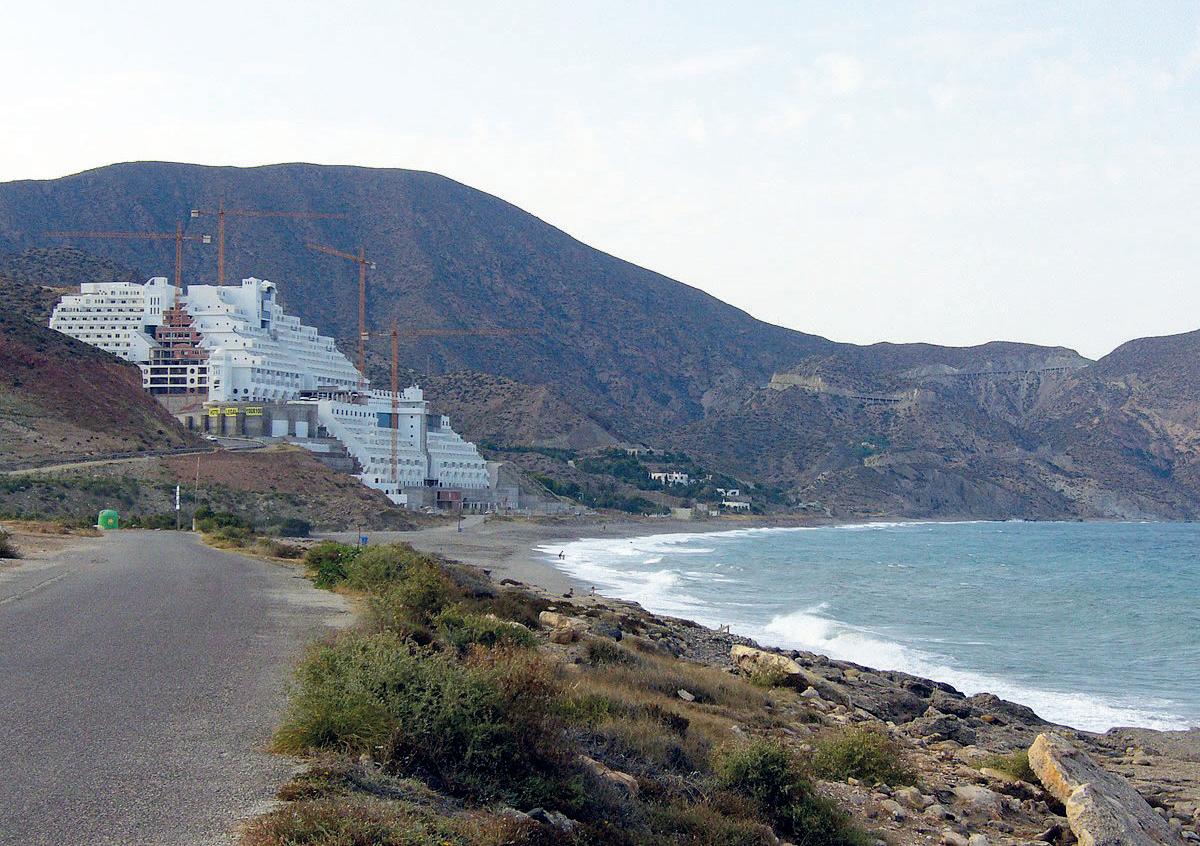
find the charming villages of Las Negras, Rodalquilar and Agua Amarga, the award-winning Genoveses and Los Muertos beaches and the chapel where Gabriel Garcia Lorca based his famous play Blood Wedding
The dusty town of Carboneras is something of an outlier. A dusty, workaday place of 8,000 souls set up around the coal industry and with unemployment fluctuating from 10 to 20%.
Feeling empty and isolated, it’s perhaps no wonder that its local politicians would want a
grand new hotel opening near the town.
The 21-floor hotel right on a nearby seafront, was seen as an act of philanthropy, injecting life and jobs into a dying community.
The locals and politicians still argue for its benefits today (somehow hoping that the recent decision will be reversed).
Mayor Salvador Hernandez sees it as a practical problem. “The building is there. Refurbish it and open it. There is nobody more respectful of the environment than the people who live in Carboneras,” he recently told the Financial Times

The Algarrobico's history began in the 1980s – well before the area was declared a national park. This was the era when the concrete-mixer was king.
Before the Marbella corruption scandals became household knowledge, developers did as they pleased.
After all, they were making Andalucia prosperous – weren’t they?

of the biggest scandals on Spain’s 5,000 miles of coastline' and claim to have won more than 40 court cases against it.
Thanks to their campaigning, the hotel has become an even bigger symbol, showing up the weakness of the law in Spain and the greed of its developers.
But while the politicians might have hoped the issue would simply melt away, green groups, also including local group Salvemos Mojacar, continued in their campaigning.
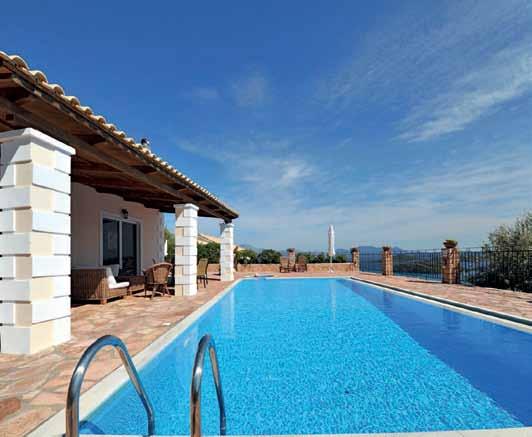
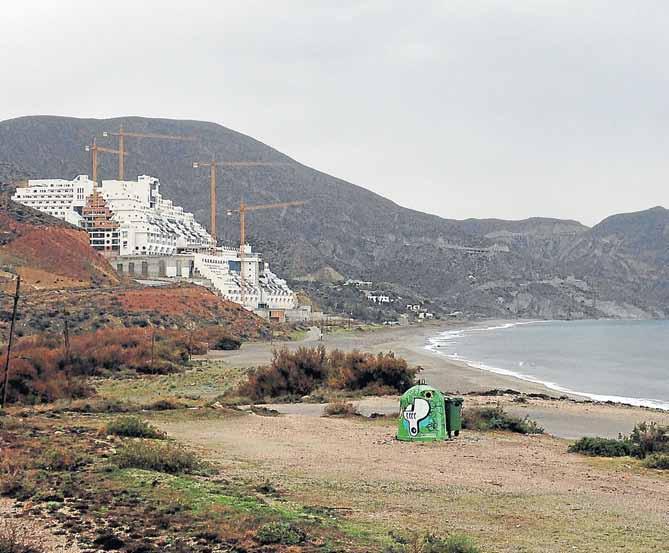





Developer Azata del Sol, owned by a wealthy Madrid family, took over the original permits handed out to another business in the 1980s . And it hasn’t helped that the courts have flipped flopped over its legality, with the Andalucian High Court, for example, actually ruling the hotel was legal in 2014.
Greenpeace and others immediately launched an appeal and legal action was even launched against the judges themselves, over claims of corruption and backhanders.
Greenpeace described it as 'one





Spain’s Supreme Court finally sided with the environmentalists, while another court formally ordered Carboneras town hall to review the hotel’s building licence – an order ignored for years. While the Junta claims it has been trying to demolish the hotel for over a decade, it needed the central government to finally rule on its ultimate destination: back to sand and dust. And even now, after everything, the PP-led regional Junta has yet to confirm its side of the bargain, with commentators suggesting it may not cooperate.
It is, in short, a tragicomic tangle of red tape and stone. “It’s a joke,” insisted activist Jaime del Val, the president of Salvemos Mojacar to the Olive Press this week. “There are thousands of Algarrobicos around Spain and this one could be stuck for 10 more years.”
While everyone is searching to understand the lessons of this costly scandal, a trio of cranes still loom over the abandoned site, which might, just might, be finally put into reverse over the next few months.
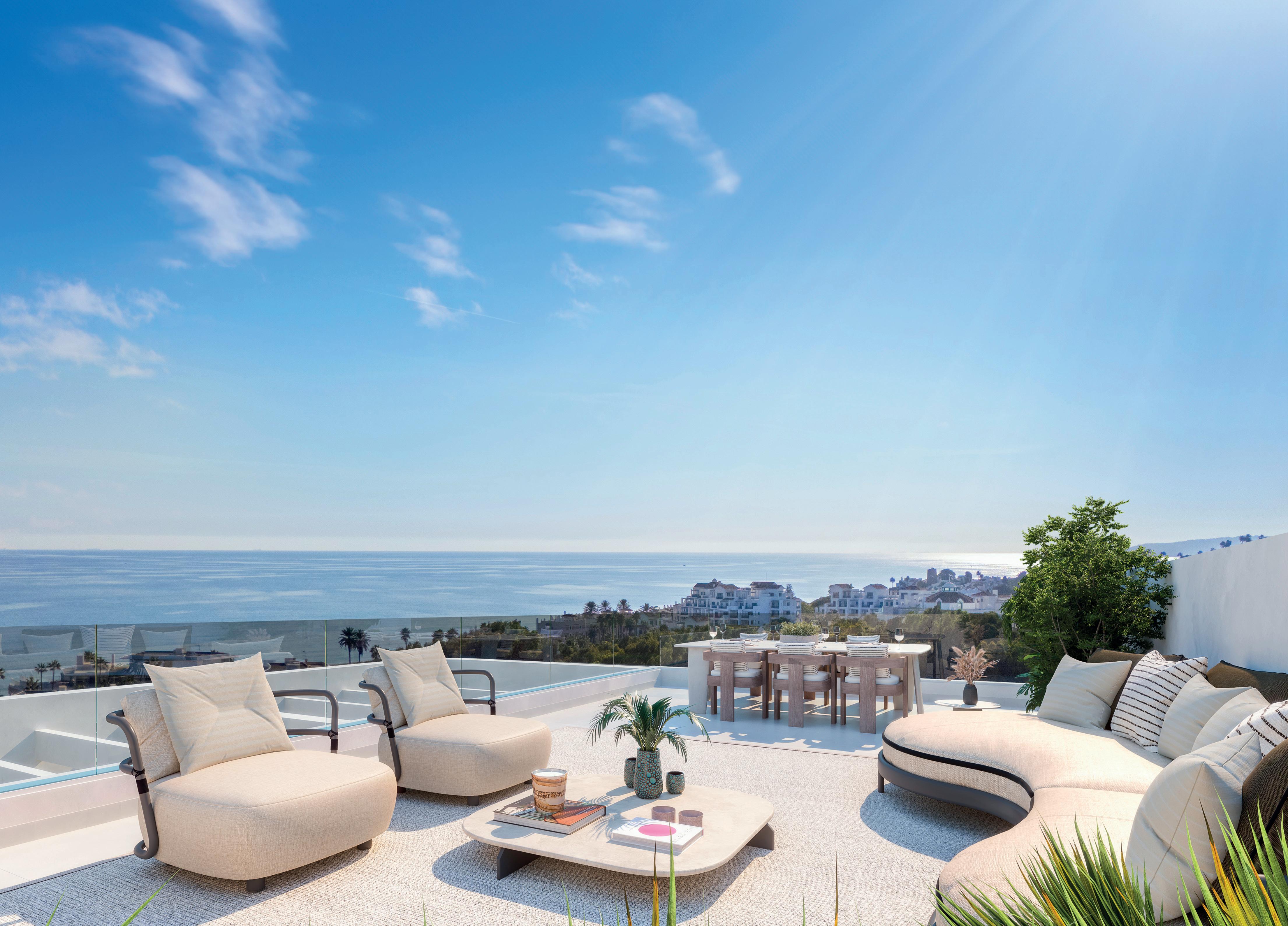


from La Cala since

NEW! – BIG RANGE OF SMALL APPLIANCES
INDUSTRIAL 18KG WASHING MACHINES WITH COMMERCIAL WARRANTY OF 2 YEARS - ONLY €1099! ALSO WE REPLACE


WATER BOILERS AND REPAIR DOMESTIC APPLIANCES




Small appliances always in stock
SPAIN’S rural heartlands are hollowing out. As young people migrate to cities and northern European ‘snowbirds’ snap up second homes, villages are left teetering on the edge of extinction. When Diego Yuste became mayor of Tragacete, a mountain town in Cuenca, in 2019, the population was in steady decline. Like many rural areas, Tragacete lacked the basic facilities needed to sustain life: schools, health centres, even a post office. Without people, they closed. Without housing, people couldn’t return.
Yuste saw potential in disused buildings – former Guardia Civil barracks and old teachers’
By Michael Coy
houses – transforming them into public rental housing. With ten units renovated, the town has seen a small but vital resurgence. The local school now has eight pupils, up from just two. “I’m always in favour of social housing,” says Yuste. “People don’t come and buy immediately. They rent, try it out. Then they commit.”
But across Spain’s interior, housing shortages are strangling revitalisation. The rural rental market is almost non-existent. Many homes lie empty most of the year, owned by foreign retirees who only visit seasonally.
THINKING of letting your Spanish property to holidaymakers? Beware. In Andalucia, some local councils are now revoking tourist licences, claiming properties breach local planning laws - particularly the PGOU (General Urban Planning Scheme). In Cordoba, dozens of landlords have received letters cancelling their tourist licences. The town hall argues that these properties don’t meet PGOU standards, especially rules about ‘adequate access’ under Article 12.4.
This affects flats with shared entrances - common in Andalucia - and even renovated loft apartments.
EmptySpain:rural exodusleavesproperty market in flux as foreignersmovein


MAGICMAYOR:DiegoYuste,Mayorof Tragacete,hasmanagedto attract people to his dying town
Jesús Patón, a 48-year-old resident in one of Tragacete’s public units, says locals are being priced out. “Everything’s going to second homes and tourist properties. For those of us who want to live here, there’s nothing.”
Lawyers at Aguirre Donate Verastegui report a wave of over 50 families affected, and suggest the move is more about revenue than regulation.
Landlords can appeal within 10 days, which freezes the process. You can argue either your access is compliant, or that you're exempt. If the council still proceeds, threatening legal action - especially if multiple landlords unite - can prompt them to back down.
The key, say lawyers, is organisation. By forming a Plataforma (pressure group), affected owners can push back effectively. What’s happening in Cordoba could soon spread to other towns. If you receive a warning, act quicklyand don’t face it alone.
The 2019 rise of Teruel Existe, a political party born from rural protest, highlighted these issues nationally. Others, like Manifiesto por Cuenca, have called for reform to support rural renters and restore vacant homes.
“There’s no widespread homelessness,” says economist Soledad Morales, “but in some areas, finding a rental is like striking gold.” There’s no quick fix. But for now, driven local leaders - and bold housing policy - may be Empty Spain’s best hope of survival and regeneration.

by mortgage broker Tancrede de Pola



MARBELLA’S property market is feeling the ripple effects of the ECB’s 2025 rate cuts.
A steady series of 25-basis-point reductions has lowered key rates, directly impacting Spanish mortgages.
The 12-month Euribor, crucial for variable-rate mortgages, has notably declined, offering relief to homeowners.
Here at The Finance Bureau, we’ve seen banks adjusting their offerings. Non-resident fixed-rate mortgages now range from roughly 2.75% to 3.5%, while variable rates are offered as low as Euribor + 0.85%. Mixed-rate mortgages, with an initial fixed period, are gaining popularity, providing a balance of stability and potential savings.
However, global events are casting longer shadows. The resurgence of protectionist policies, notably potential tariffs and trade disputes stemming from Donald Trump’s political influence, adds a layer of uncertainty. Such policies could disrupt global trade flows and potentially reignite inflationary pres-
But will Trump’s tariffs upset the markets and affect interest rates?
sures. This could lead the ECB to reconsider its current easing stance, potentially reversing the downward trend in interest rates.
For those considering mortgages in Marbella, this means a need for vigilance. While the current climate favours borrowers, future global economic shifts could alter the landscape. The Spanish economy, though currently strong, remains susceptible to external shocks.
Therefore, whether seeking a fixed, variable, or mixed mortgage, it’s imperative to consider both current ECB trends and potential global economic headwinds.
The current relatively low Euribor rates (coming down after the shock of the pandemic) offer an excellent opportunity for those getting onto fixed-rate mortgages, but the future is uncertain.
At The Finance Bureau, we recommend consulting with experienced professionals to navigate this complex environment and secure the best financial solutions for your needs.
To contact Tancrede for all your mortgaging needs call: +34 666 709 743 or for insurance queries call: +34 952 801 401 Email: tdp@thefinancebureau.com
The Finance Bureau Centro Comercial Guadalmina II, Oficina 7, Guadalmina, 29670, Spain

SWORN TRANSLATION
We provide official translations with legal validity, carried out by sworn translators
TRANSLATION
We can translate any kind of document: touristic, websites, medical etc
INTERPRETING SERVICE
Liaison, consecutive, simultaneous and whisper interpreting
SEO FRIENDLY COPYWRITING For blogs and websites
GET IN TOUCH FOR A FREE QUOTE
CONTACT:
hola@lafabricadetraducciones.es +34 680 186 708 www.lafabricadetraducciones.es
More than 30 language combinations
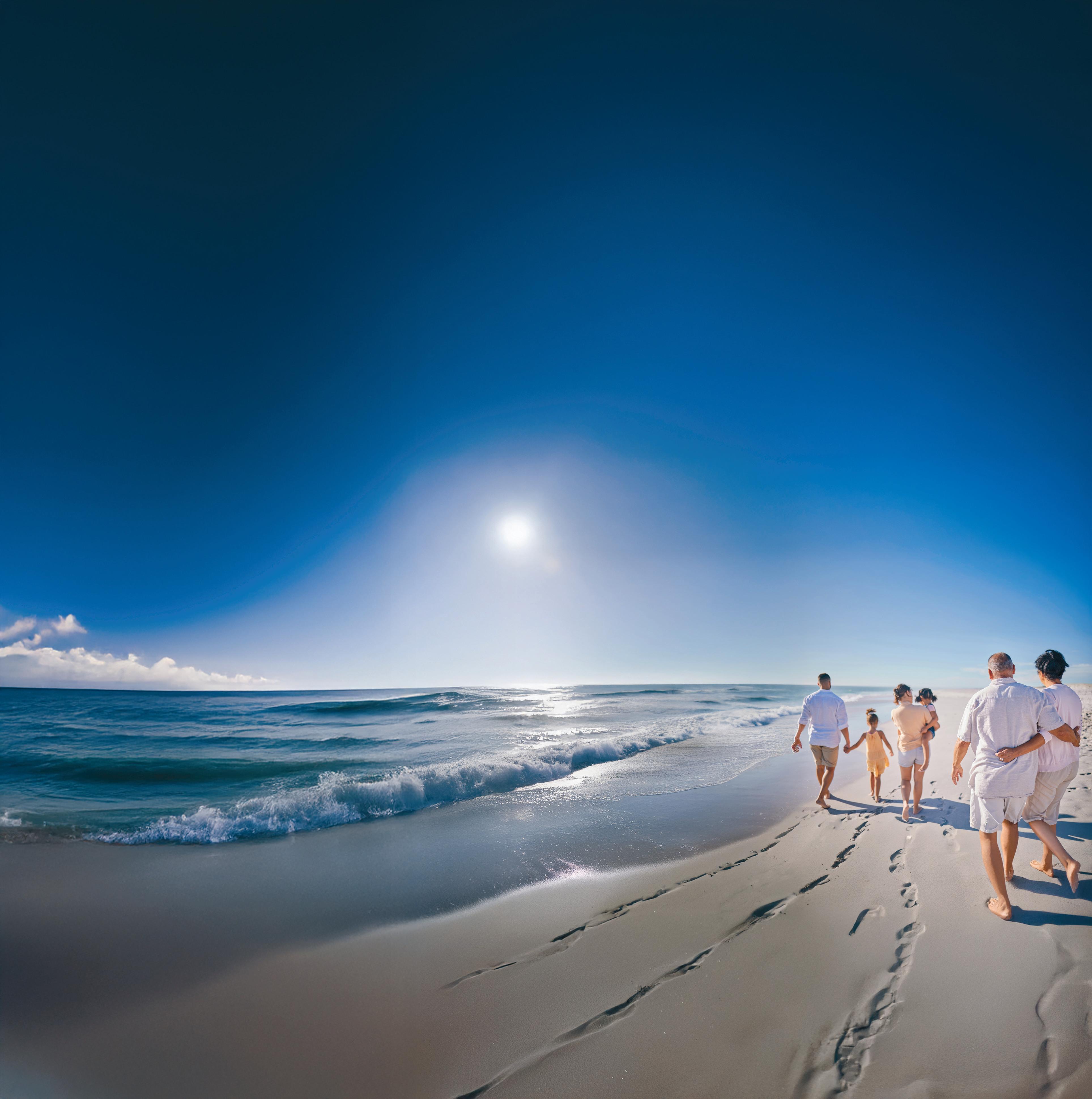

THowever,
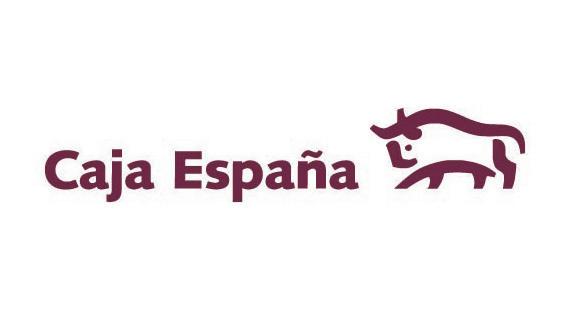


The clients are named Turner and the house is in Orihuela... and the ‘floor clause’ affected mortgage was approved in 2008
sands of homeowners spent years paying hundreds of euros more per month than they should have done.

One legal firm in southern Spain has been at the forefront of winning back money for affected homeowners – and on a promised ‘no win, no fee’ basis.
Fairway Lawyers boss Diego Echavarria, based in Marbella, told the Olive Press that one of his latest clients, the Coopers, were recently awarded a total of €21,075, plus legal costs.



The British family had bought a home in Riviera del Sol, in Mijas, in 2006, but didn’t sell up until recently. They were totally unaware of the floor clause issue until they read about it in a copy of the Olive Press last year. Now, after six
months of legal wrangling, Echavarria, originally from Madrid, has won them the fee, plus compensation.
“It’s always a bit of a game and involves plenty
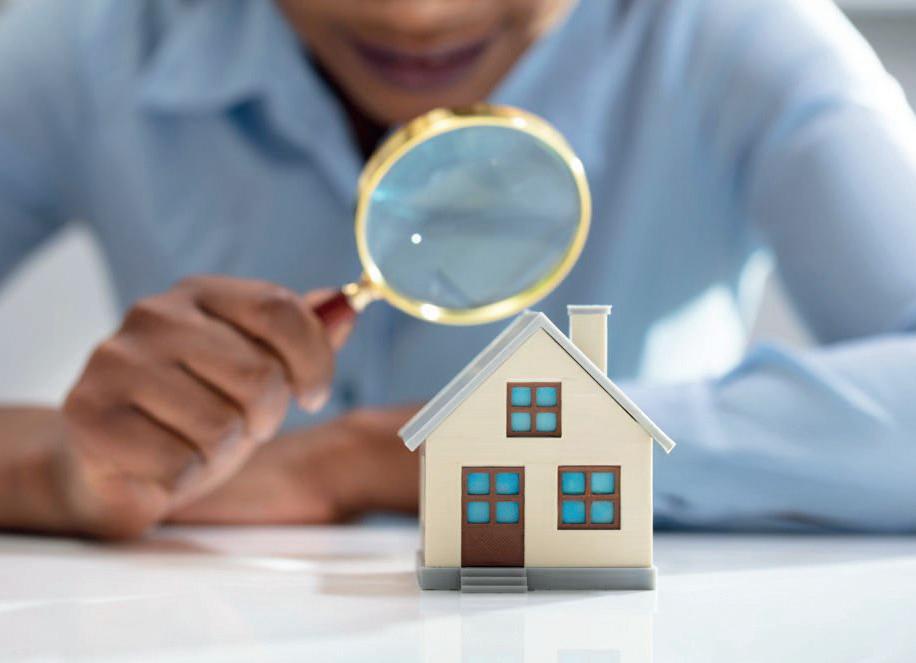
of legal letters being pinged backwards and forwards, but I know what I’m doing having done this for years now,” he explained.
It comes after the golf-loving lawyer, a member of Guadalmina, won another British couple, the Brighouses, €48,359, last summer.
The couple had bought an off-plan apartment in Mirador de Costalita, in Estepona, in 2004.
They took over the mortgage from the developer, which contained the hidden clause and they ended up paying an extra €250 per month than required. It was the fourth case Fairway Lawyers have won on homes in Mirador de Costalita alone.
There are thousands of similar cases all around Spain in which expats or former expats had no idea they were victims.
“Right now I am handling cases all
over the country,” explained the father-of-two.
There are two tell tale characteristics to look out for; Your mortgage was signed off between 2001 and 2010 and your payments were the same amount for a large number of years.
“What is key is they will not have lowered for years,” continued the lawyer, who also handles many other legal work, in particular conveyancing from his office in Marbella.
He added: “Even if you have sold the property and paid off the mortgage, you can still claim.
“There is no deadline since the latest ruling from TJUE (Tribunal de Justicia de La Union Europea).
“There are around 100,000 mis-sold mortgages that have yet to be resolved in Spain.”
If you want to claim for a mis-sold mortgage or feel you may have been affected, contact diego@fairwaylawyers.com or send a message via Whatsapp to +606 307 885

Most Spanish banks, but especially Banco Popular (now merged with Santand- er), Caja Duero, Caja España (merged with Unicaja), La Caixa, Solbank, Sabadell and many other savings banks which have since been taken over by major banks.
WHAT IS THE PROCESS FOR MAKING A CLAIM?
You need to submit a claim be- fore the bank to try to reach a settlement out of court. Then comes a three-month period in which you await their response. Unfortunately the Spanish banks do not want to reach any kind of agreement or set- tlement and they always force the clients to go to court to get a positive ruling. They do this because they hope clients will get fed-up with the process and drop the claim – which is why we operate on a no win no fee basis.
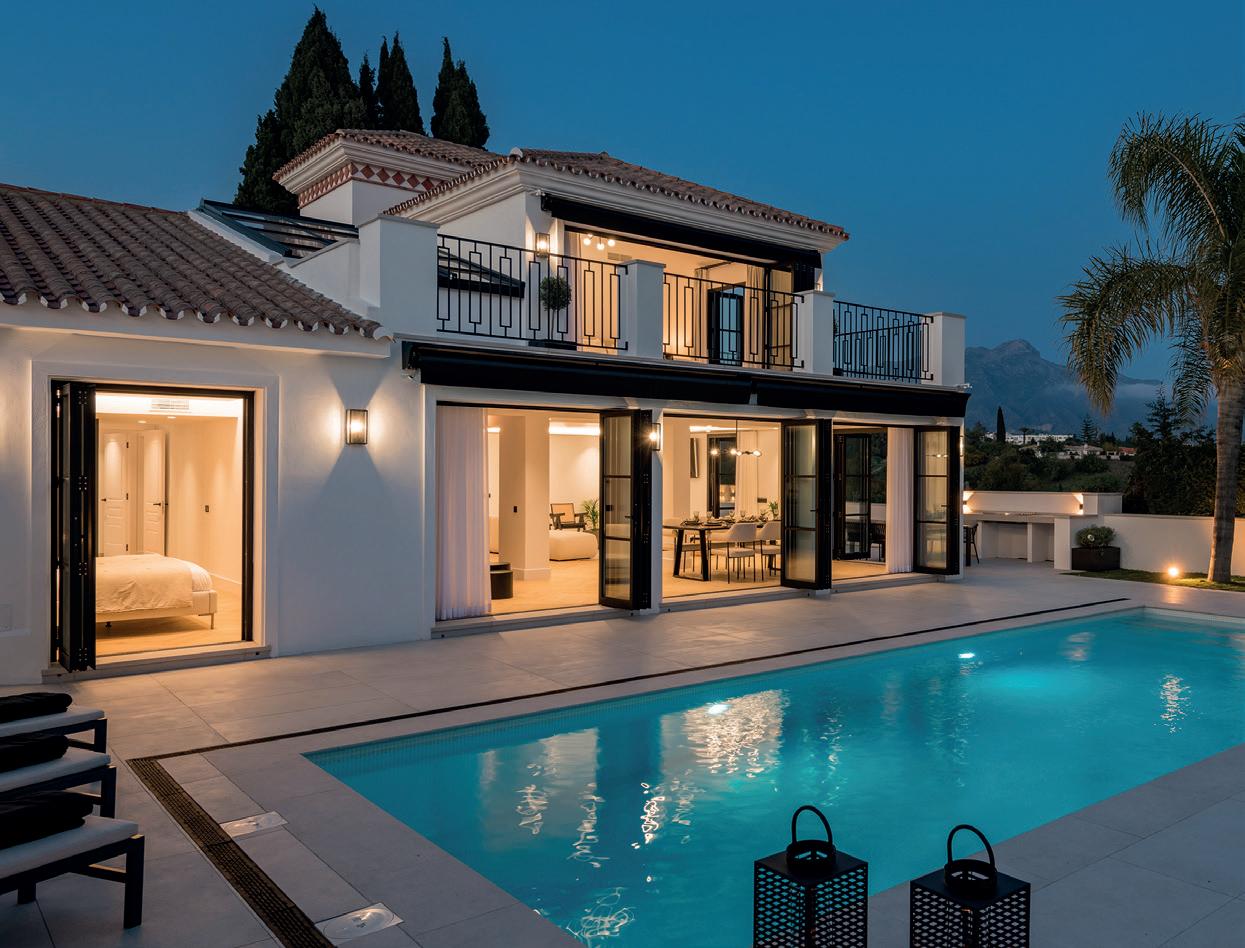

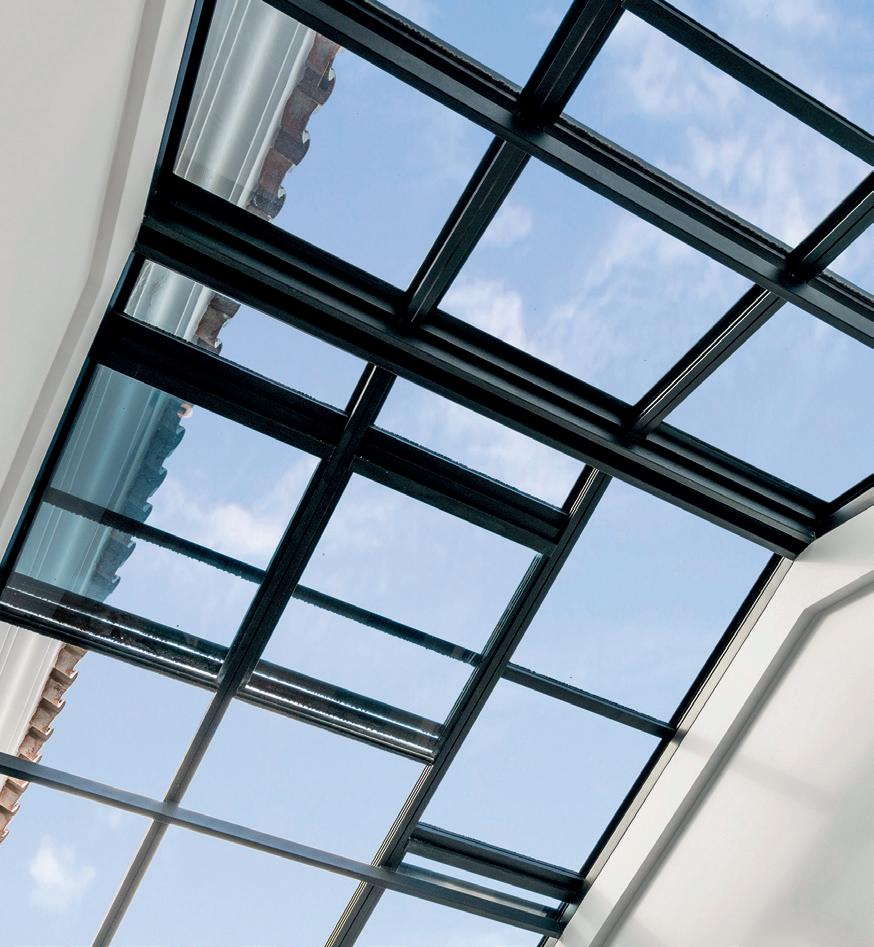





by Adam Neale
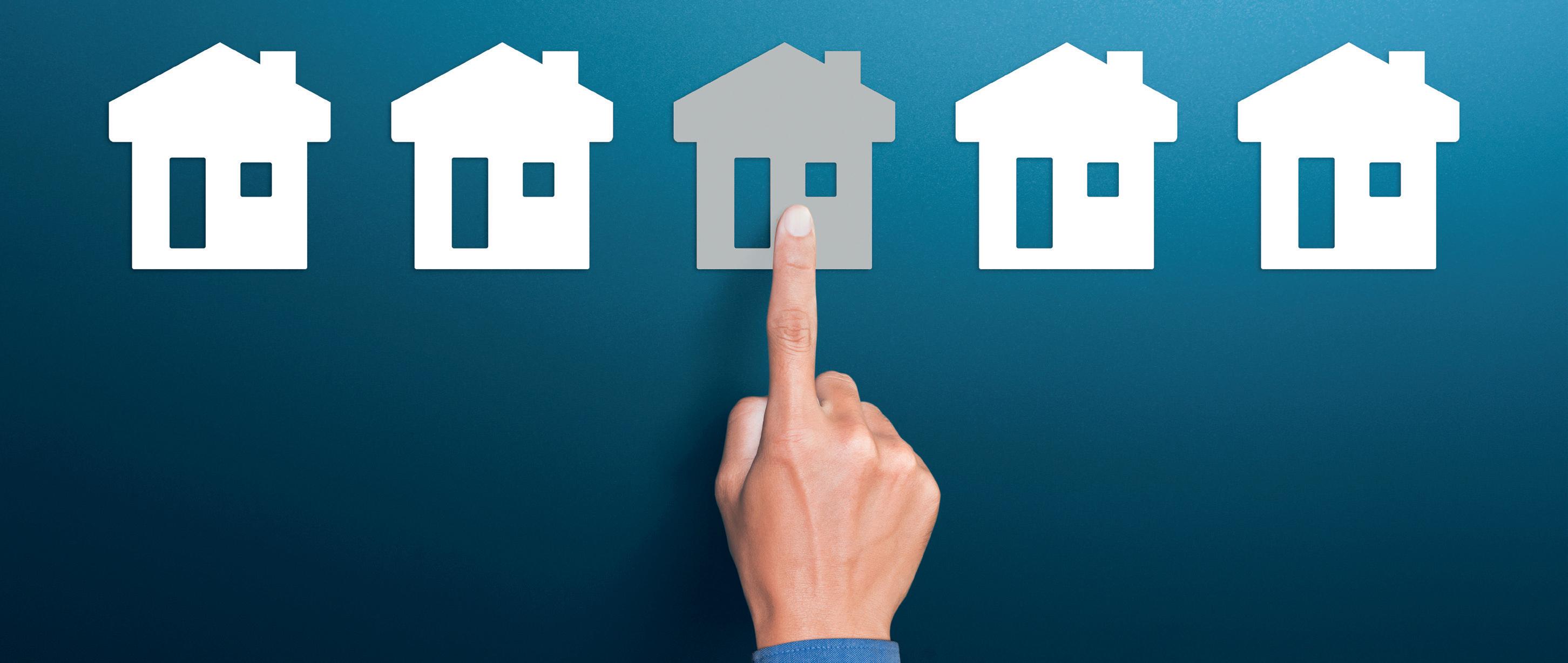
The situation with rental housing availability in Spain remains abysmal. The number of long term rental units continues to drop as demand continues to rise. We need a solution but there’s no “silver bullet.”
At the beginning of April, hundreds of thousands of Spaniards demonstrated in over 40 cities demanding real solutions. Everyone agrees that something has to be done, rental costs are rising at a rate higher than incomes or the rate of inflation.
In 2024, rental prices in Spain as a whole rose by 11.5%. That was spread unevenly, meaning that in Spain’s cities, rental prices rose more steeply, with Barcelona witnessing a rise of 13.5%, and 15.3% in Madrid.
This comes against the backdrop of a new housing law in Spain, which regulates prices, rental contracts, legal remedies for okupas (home occupations), as well as tax incentives for landlords who provide long term rental contracts at government set rental rates - or lower.
In Spain’s fractured political landscape, it’s no surprise that this law has generated a lot of debate. Is it throwing gasoline on the fire? Is it a solution? Or is it neither?
To understand what is unfolding and the likely impact of the current round of reforms, we need to take a deeper look at the situation.
The place to start is the imbalance between supply and demand. This is really the root of the problem. Ironically, it is itself caused by measures that are meant to solve other crises.
It’s not a secret that Spaniards are not having children at anything close to the rate needed to replace the aging population. The rate of replacement is currently 2.1 children per female but
Spanish born women are only having 1.12 babies per woman. This represented a decline of 2.6% compared to the year prior.
Without immigration, Spain would suffer a number of problems due to the decline in the workforce and the relative rise in the number of pensioners
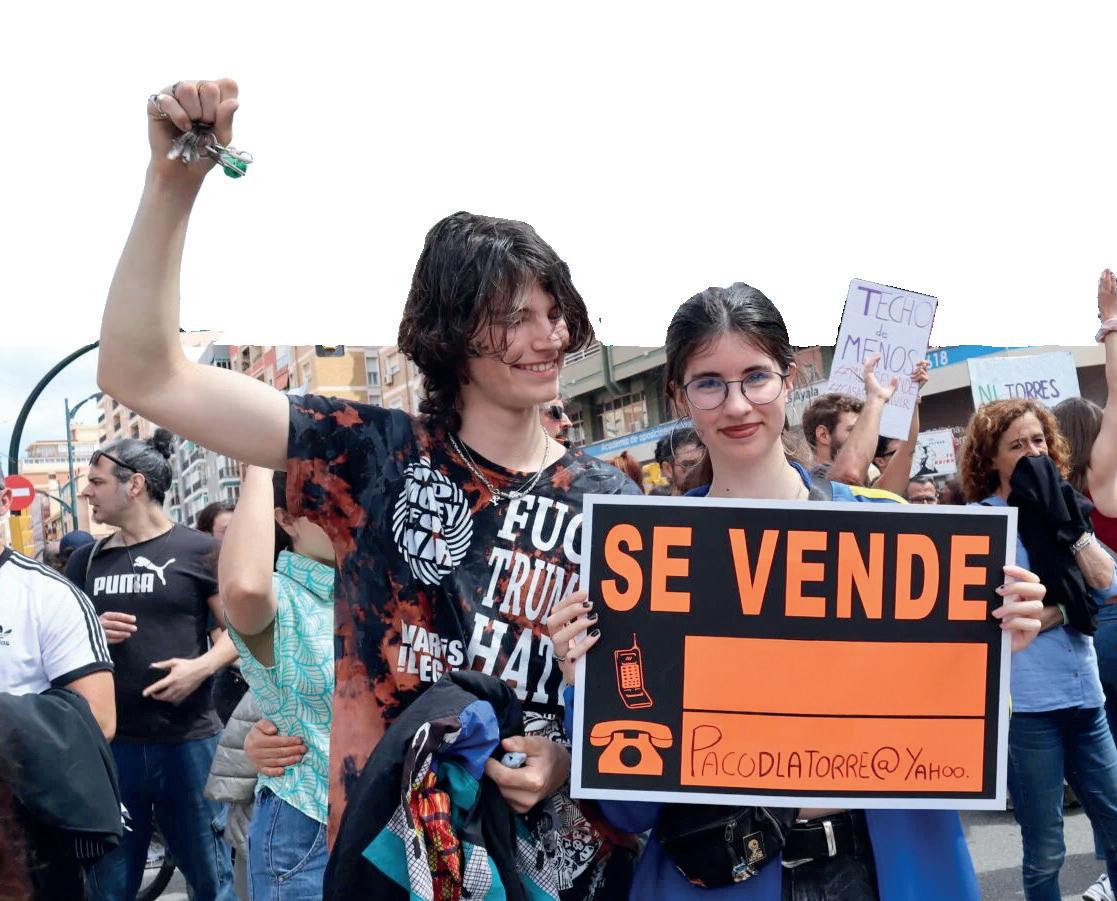
drawing on their public pensions, for example. It would also damage the ability of Spain to grow and modernise its economy.
According to a report by the Bank of Spain, for instance, Spain will need 25 million immigrants by 2053 - three times the current rate of immigration - to keep the pension system solvent.
For these reasons, the Spanish government has resisted the trends in the rest of Europe to restrict immigration. In 2023, Spain had net external migration (immigrants arriving) of 1.32%, or 642,000 people.
That’s all well and good but all of those people arriving need quality places to live - and Spain isn’t building enough of them. Last year, the number of new households in Spain grew by 360,000. That is expected to ease slightly to 355,349 in 2025-2026, and then 337,864 in 2026-2027.
The number of new houses being built is growing for the first time really since the bottom of the banking crisis in 2014-2015. According to a study by Caixa Bank, this trend will continue and even gather pace.
“...we have raised our forecast for new construction permits from 125,000 to 135,000 in 2025, after they gained traction in 2024 (+16.5% year-on-year in January-October of 2024, reaching around 125,000 permits in the trailing 12 months).”

This is good news but is nowhere near enough.
The result is that the deficit in housing supply will continue to grow in the coming years. Yet no one is willing to seriously work to solve the problem because it is costly in both political and economic terms.
The position of the far
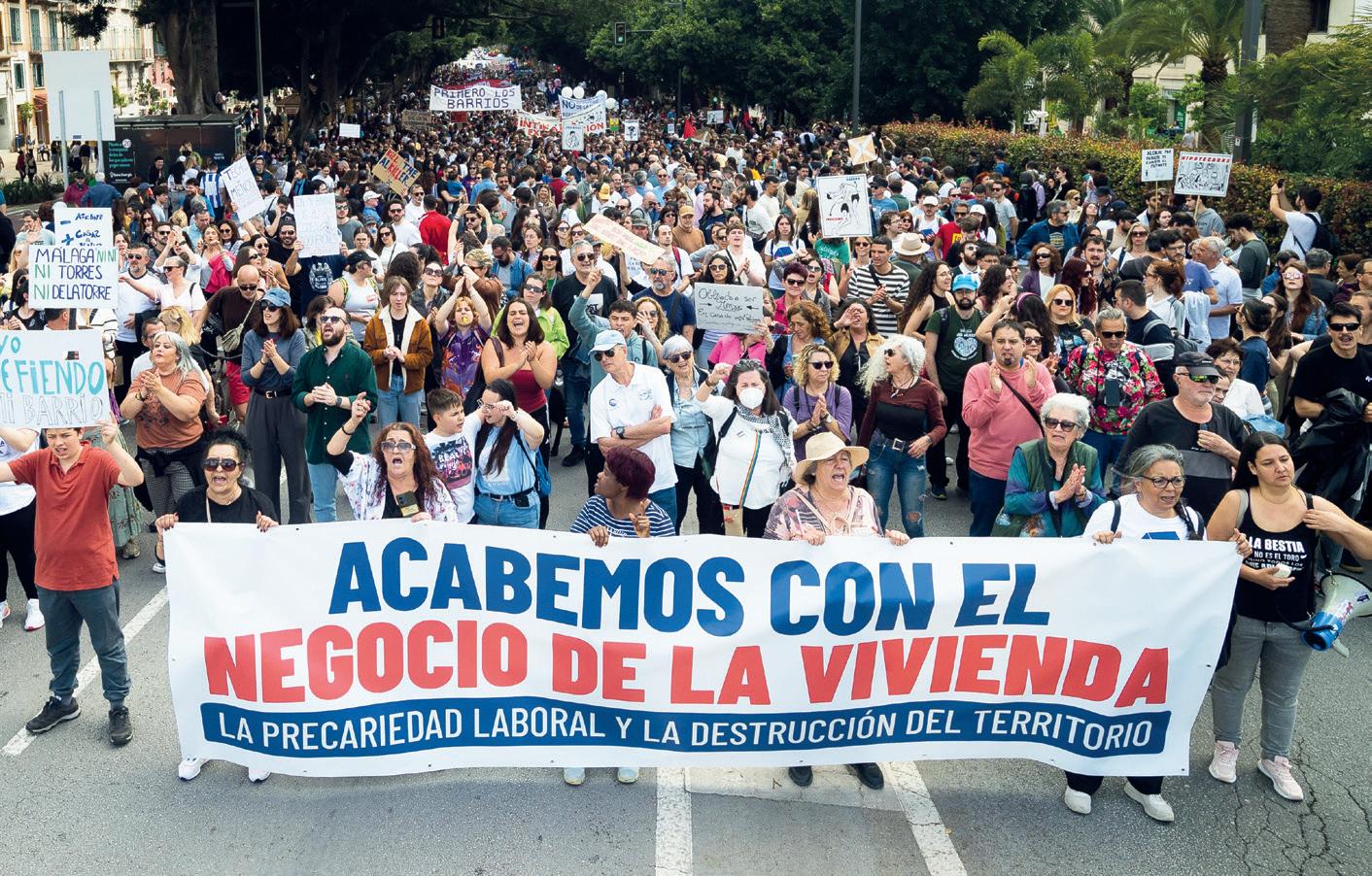
end immigration and repatriate those who have arrived. But that is impossible and would lead to economic and social collapse, from public pensions to the healthcare system to the overall economy.
That means addressing the housing crisis head on - but is anyone doing that?
The new housing law was promoted as a solution to the current crisis. It gave tenants new rights, reduced the ability of landlords to raise prices and offered incentives to landlords to rent long term and hold the line on rent increases. There’s also direct aid to young home buyers (under 35-years)
On the other side, it also provided repressive measures to try and shift the rental market. There were reforms to discourage and regulate tourist rentals, for instance. And removing and penalizing home occupations (okupas) is now easier and quicker. Financial pressure will also be applied to large landlords who have empty properties, imposing significant property tax increases.
3x the rate of inflation - or more - the impact looks to be to push landlords into the medium-term rental market.
According to a study by real estate portal Idealista, the number of listings for long term rentals declined by 5% between 2023-2024. Those of seasonal rentals rose by 39%
There is no direct relationship between listings and the actual number of people living in long term rentals. Part of the disparity could reflect the fact that those in long term rental units are avoiding moving because they will face significant rent hikes.
deficit in housing
will continue to grow in the coming years
However, it seems like nobody is happy with the current approach. The demonstrations in early April made it clear that a lot of people think the current approach is too timid. On the other side, business and landlord groups think that the law infringes upon landlord rights and market mechanisms that would reduce the problems.
Some of the immediate effects are becoming clear. Others will take time to unfold, such as the impact of changes to tourist rental laws or the house purchase grants for young people.
In the context of rental prices rising at
However, there is an obvious incentive for landlords to rent for a season, rather than long term. They cannot raise rents on long term rentals by more than 3%. However, if they rent to students, at the end of the school year when they move out, they could raise the rent on an apartment by 10-15%.
Is this shift to seasonal rentals caused by the Housing Law? In a sense, yes. But the bigger issue remains that there’s not enough new housing being built to meet demand - both for purchase or rental. That is creating incentives that distort the housing market away from meeting the needs of Spaniards.
However, that doesn’t mean that there’s nothing that can be done. There are interesting housing reforms that we can look at that take as their principle stabilizing the landlord-tenant relationship.
In Scotland, for instance, they passed a law in 2016 that did just this. It laid out the 18 specific conditions under
which a landlord could have a tenant removed. It also eliminated fixed rental periods entirely and provided a standardized contract for all landlords/ tenants.
In addition, they added the role of rent guarantor. A landlord who has concern about the creditworthiness of a potential tenant - such as a young person seeking to rent their first apartment, or a low income family - can insist upon a rent guarantor.
A rent guarantor is a person, or company, that guarantees that if the tenant defaults, the landlord will not lose rental income. This creates great incentive for landlords to “take a chance” on renting to vulnerable and “high-risk” tenants.
Spain is looking towards a statebacked version of this, known as aval público. It will have stringent conditions and require consent of both parties. It won’t eliminate the deeper structural causes of high rents and lack of rental housing.
But the aval público will at least overcome one major concern of landlords when it comes to long term rentals. And making it a public service, rather than private, makes it more accessible to the most vulnerable. The vulnerable are the least likely to have access to someone with a high credit rating.
It is important to see the good and the bad in the current situation. And also to keep our eyes on the fundamental problem of a lack of supply. Until that is fixed, everything else will just be delaying the day of reckoning.



DEL

Ref: OP15431
589 m² | Plot: 2,293 m² | Beds: 5 | Price: € 5,950,000


MODERN APARTMENT, MARINA PUENTE ROMANO Ref: OP15580 Built: 118 m² | Terraces: 18 m² | Beds: 3 | Price: € 2,995,000


PENTHOUSE, LOMAS DEL REY Ref: OP15125
163 m² | Terraces: 113 m² | Beds: 3 | Price: € 2,490,000

LAS
Ref: OP15069 Built: 669 m² | Plot: 1,590 m² | Beds: 7 | Price: € 3,995,000
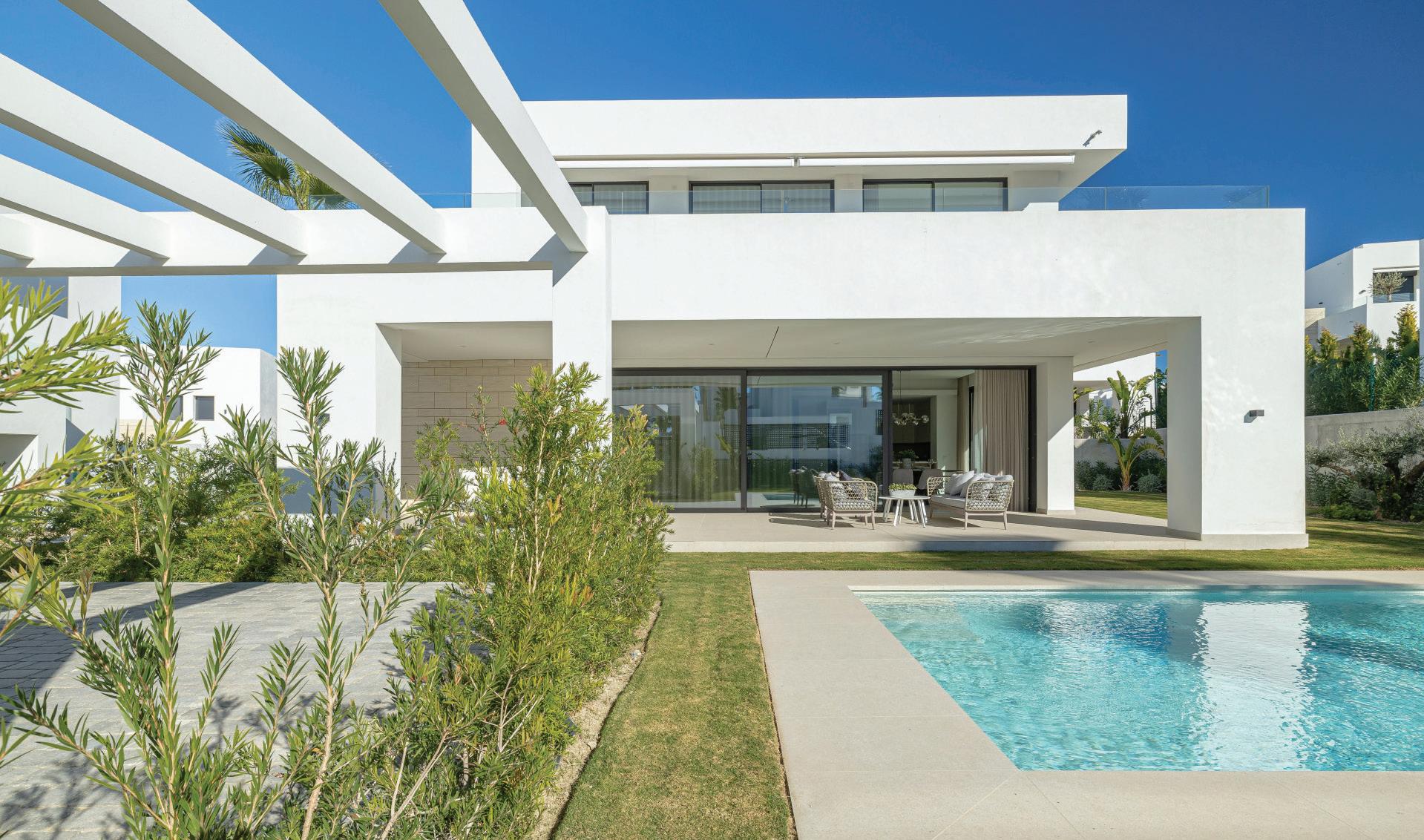

VILLA, LA FINCA DE MARBELLA Ref: OP15369 Built: 371 m² | Plot: 653 m² | Beds: 6 | Price: € 2,795,000
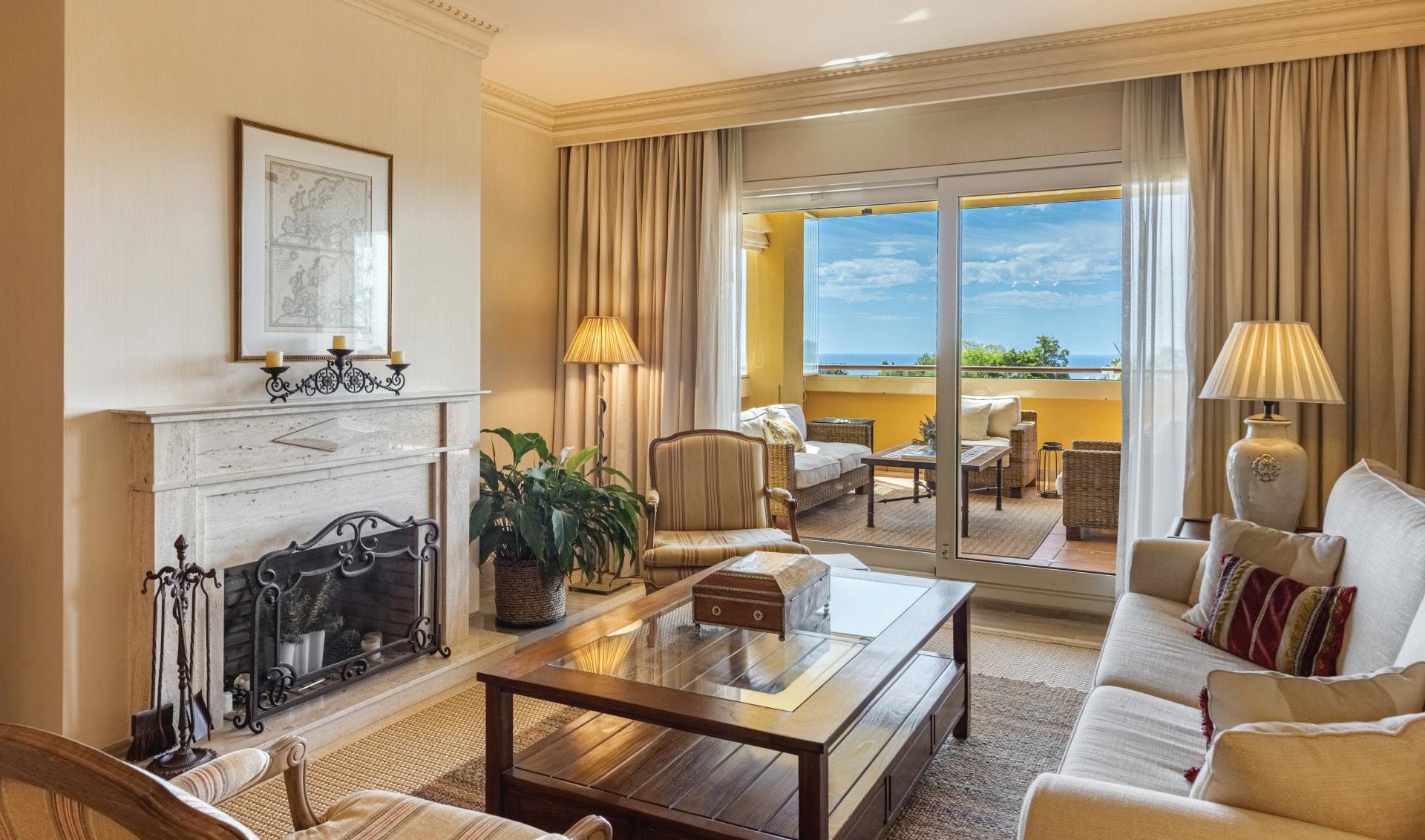

IN CONDADO DE
Ref: OP15672
147 m² | Terraces: 42 m² | Beds: 3 | Price: € 950,000
at Puente Romano and opposite the Marbella Club hotel